当前位置:网站首页>UDS learning notes on fault codes (0x19 and 0x14 services)
UDS learning notes on fault codes (0x19 and 0x14 services)
2022-07-06 11:18:00 【Zhikongtong】
Catalog
2.1.1DTC The severity of and the definition of classes
2.1.2 Conventions and definitions
2.1.3DTC Status bit definition
2.1.4DTC Status bit definition
2.1.5 DTC Format identifier definition
3. Clear diagnostic information (0x14) service
3.2 The request message [ message ]
3.2.1 Request message definition
3.2.2 Request message subfunction parameters $Level(LEV_) Definition
3.2.3 Request message data - Parameters are defined
3.3.1 Positive response message definition
3.3.2 Supported negative response codes (NRC_)
4. read DTC Information (0x19) service
4.4 retrieval DTCS Snapshot record id ( Subfunctions =0x03 The report DTCS Snapshot ID )
4.26 The request message [ message ]
4.26.1 Request message definition
4.26.2 Request message subfunction parameters $Level(LEV_) Definition
4.26.2 Request message data - Parameters are defined
4.27 Positive response message
4.27.1 Positive response message definition
4.27.2 Positive response message data parameter definition
4.28 Supported negative response codes (NRC_)
1. summary
Clear diagnostic information : Allow the client to clear the diagnostic information on the server ( Include dtc、 Captured data, etc ).
Read DTC Information : Allow clients to request diagnostic information from the server ( Include dtc、 Captured data, etc ).
Icon description :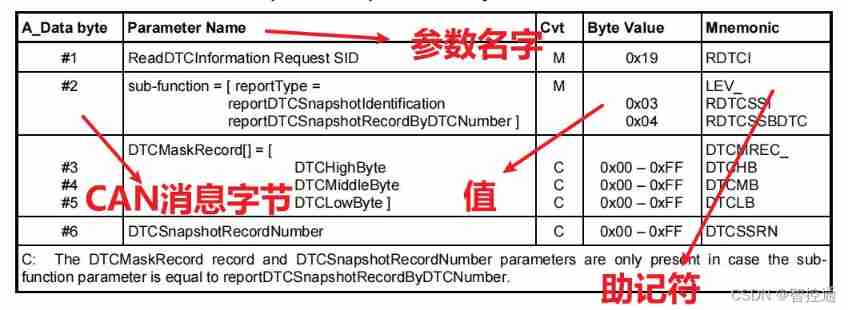
2.1 DTC describe
2.1.1DTC The severity of and the definition of classes
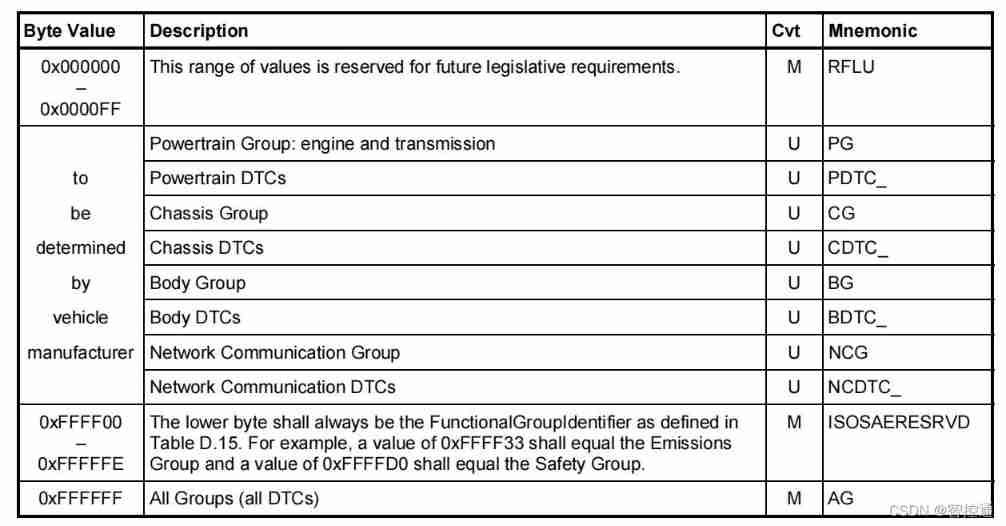 The request message of the client contains a parameter . Parameter group ofDTC Allow clients to clear a set DTC( for example , Power train 、 body 、 Chassis, etc ), Or a specific DTC. See the above table for details . Unless otherwise stated , The server should clear emissions related and non emissions related... From the memory of the requested group DTC Information .
The request message of the client contains a parameter . Parameter group ofDTC Allow clients to clear a set DTC( for example , Power train 、 body 、 Chassis, etc ), Or a specific DTC. See the above table for details . Unless otherwise stated , The server should clear emissions related and non emissions related... From the memory of the requested group DTC Information .
2.1.2 Conventions and definitions
This clause defines when reading DTC Used in information services DTC Status mask / In state DTC Mapping of parameters . Each server should comply with the bit packaging defined in the following table DTC Agreement of status information . The actual use of the bit field should be defined in the implementation standard .
The state of the test fault bit should not be directly associated with the fail safe behavior associated with the monitor state . This means that in order to trigger fail safe behavior associated with the status of a monitor , A separate set of status bits needs to be maintained . The vehicle manufacturer shall define whether and how to apply and implement DTC Any synchronization mechanism between status and fail safe related monitoring status .
The following is used to describe DTC Definition list of status bit definitions :
Test: Testing is an on-board diagnostic software algorithm , It usually determines the fault status of components or systems in a single operation cycle . Some tests run only once in an operation cycle . Other tests can run each program cycle , Sample every few milliseconds . The final result of the test represents a complete maturity / Qualified conditions ( Pass or fail ). It refers to the test that requires the occurrence of failure conditions within a specific time or the evaluation of additional rationality checks before the component fails , Only after all mature conditions are met will it return “ Failure ” Conditions . Every DTC Are associated with a test that represents detectable fault symptoms .
Test Sample: When the test running conditions are met , The test sample is from DTC Of a single instance of test execution “pass” or “fail” result . This represents a single sample , Therefore, it is usually not a fully mature / Qualified conditions . For support DTC Fault detection counter ECU, Test samples representing faults will increase DTC Fault detection counter , And the number of test samples passed by representatives will be reduced DTC Fault detection counter .
Complete: Completion indicates that the test can determine whether there is a fault or no fault in the current operation cycle ( Completion does not mean failure ).
Test results: When the test is run or completed , It may indicate the following results to the internal fault handler :
1.PreFailed: This status can be used for ecu Test in , To show that the test is currently in mature fault conditions . One of the messages The first use case is to speed up the fault detection of optimized workflow in manufacturing , While maintaining fault tolerance on site .
2.Failed: This state is available after the test runs to its completion , And it indicates that there is a fully mature failure state .
3.Passed: This state is available after the test runs to its completion , It indicates that the system or component has not failed .
Failure: Failure means that a component or system cannot meet its expected function . When the fault condition is detected for sufficient time , It's going to break down , This means that the test returns “ Failure ” result . The term "failure" and "malfunction" It's interchangeable .
Monitor: The monitor consists of one or more tests , Used to determine the normal function of a component or system .
Monitoring cycle: The monitoring cycle is the time when the monitor runs completely . This is a set of conditions defined by the manufacturer , in the meantime , The test of the monitor can run . A monitoring cycle can be executed several times in an operation cycle , Or execute once in multiple operation cycles .
Operation Cycle: The operation cycle defines the start and end conditions of the monitor operation . In an operating cycle , Multiple monitoring cycles may have been completed ( Regardless of the test results ). One ECU It can support several operation cycles . For body and chassis ECU, The operating cycle is determined by the manufacturer ( for example , Power on and off ECU Time between ignition on and ignition off ). For power train ECU, There is also an additional standard for defining the operating cycle . Emission related powertrain ECUs Use a period of time when the engine is running or shut down to define an operation cycle , This is called the drive cycle . If one DTC The reset condition of the status bit is associated with the beginning of the operation cycle , Then it can also be regarded as the end of the previous cycle ( namely , It is not always possible to distinguish the beginning and end of each operation cycle ). For emission related monitoring personnel , The standards for the beginning and end of the operation cycle are stipulated by legislation .
Pending: The failed pending status is defined as the... That reports this test in the current operation cycle or the last completed operation cycle “Failed” Test of results . Once the test reports the complete operation cycle of this failure “Passed” Conditions , Instant state .
Confirmation Threshold: The confirmed failure status is defined as the test report within a given number of operation cycles completed by the test run “ Failure ” Test of . Usually for non OBD Use cases , The threshold of the operation cycle is defined as 1. about OBD Use cases , This threshold is usually greater than 1. Implementation can use Trip Counter ( See chart D.9) As a trigger, the confirmed state is changed from 0 Change to 1. The travel counter counts the operating cycle of failure ( Drive cycle ) The number of times . If the counter reaches the threshold ( for example ,2 Drive cycles ), Then confirm the bit from 0 Turn into 1.
Aging Threshold:DTC Aging is defined as a test report without “Failed” The result is to define operations for a given number of automakers or regulators cylces Specific to the vehicle manufacturer, if the respective cycle triggers an increase in the aging counter, it depends on whether the test runs to complete the cycle . The implementation can use an aging counter ,( See the picture below ) As a trigger , Change the confirmed status from 1 Change to 0, And delete from the nonvolatile memory DTC Information . The aging counter calculates the number of cycles that meet the above criteria ( for example , Warm up period ). If the counter reaches the threshold ( for example ,40 Preheating cycle ), Then the confirmed bit will be from 1 Turn into 0.
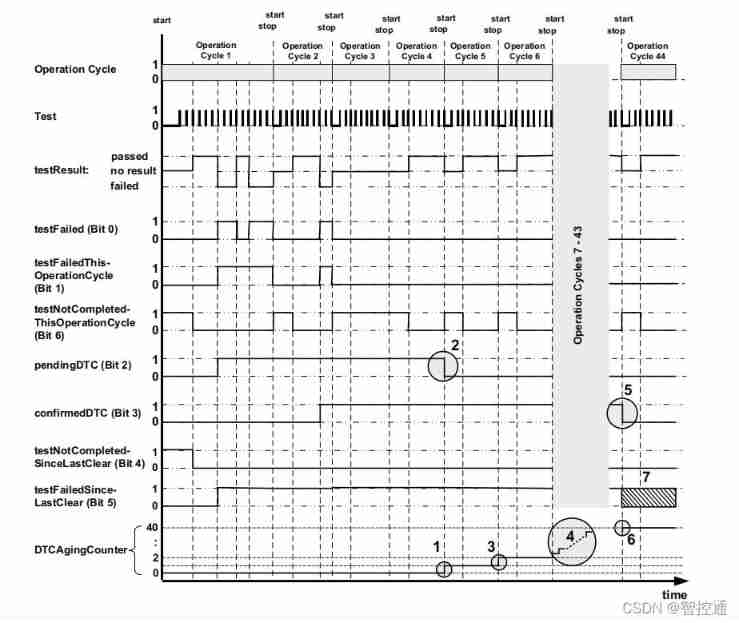
Driving cycle: For emissions related ecu A specific type of operation loop . For details, see “ Operating cycle ”. In emissions related ECUs in , Only one run cycle is supported , This is the same as the driving cycle stipulated by the legislation .
Monitor Level Enable Conditions: Standards that allow monitors to run and report test results / Conditions .
DTC Status Update Condition: The monitor allows you to update all DTC The status of the status bit ( for example , control DTCS The setting type is not equal to ‘ close “). This general condition applies to all DTC Status bit transition , Except for triggered status bit reset .
DTC Storage Condition: Conditions defined by the vehicle manufacturer , Indicates the relevant that can be updated DTC Status bits and Correlation DTC data ( Such as DTC Expand or snapshot data ) Whether it is updated and stored in nonvolatile memory .
2.1.3DTC Status bit definition
2.1.3.1 testFailed
This bit should represent the result of the most recently executed test . Logic “1” It should indicate that the last test failed , It means failure is fully mature . If the recently executed test result returns “pass” result , It means that all immature conditions are met , Reset to logic “0”. Additional reset conditions can be determined by the vehicle manufacturer / Implementation agencies to define
IF (initializationFlag_TF == FALSE)
Set initializationFlag_TF = TRUE
Set testFailed = 0
IF ((most recent test result == PASSED) OR
(ClearDiagnosticInformation requested == TRUE) OR
(vehicle manufacturer/implementation reset conditions satisfied))
Set testFailed = 0
ELSE IF (most recent test result == FAILED)
Set testFailed = 1Definition DTC Status bit “0” The logic of test failure

This bit should indicate whether the diagnostic test has reported a test failure result at any time in the current operating cycle ( Or the test failure result is reported in the current operation cycle and after the last call to clear the diagnostic information ). After starting a new operation cycle or calling clear diagnostic information , Reset to logic “0”. If this bit is set to logic “1”, Then it will remain “1”, Until the start of a new operation cycle .
IF (initializationFlag_TFTOC == FALSE)
Set initializationFlag_TFTOC = TRUE
Set testFailedThisOperationCycle = 0
Set lastOperationCycle = currentOperationCycle
IF ((currentOperationCycle != lastOperationCycle) OR
(ClearDiagnosticInformation requested == TRUE))
Set lastOperationCycle = currentOperationCycle
Set testFailedThisOperationCycle = 0
ELSE IF (most recent test result == FAILED)
Set testFailedThisOperationCycle = 1Definition DTC Status bit “1” Test failed this operation cycle logic .

IF (initializationFlag_PDTC == FALSE)
Set initializationFlag_PDTC = TRUE
Set pendingDTC = 0
IF (ClearDiagnosticInformation requested == TRUE)
Set pendingDTC = 0
ELSE IF (most recent test result == FAILED)
Set pendingDTC = 1
ELSE IF ((currentOperationCycle == stop) AND
(testNotCompletedThisOperationCycle == 0) AND
(testFailedThisOperationCycle == 0))
Set pendingDTC = 0Definition DTC Status bit “2” Hang up DTC Logic
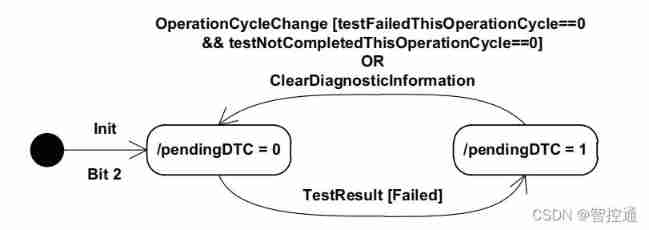
2.1.3.4 confirmedDTC
This bit should indicate whether a fault has been detected for sufficient time , To ensure hope DTC Stored in long-term memory . Confirmed DTC It does not always indicate that there was a failure at the time of the request .( Test failure can be used to determine whether there is a fault when the request is made ). After calling to clear the diagnostic information or meeting the aging threshold , Reset to logic “0”( for example ,40 Engines warm up without other faults detected ). Besides , When with this DTC Relevant fault records are updated according to the vehicle manufacturer's specific fault memory overflow requirements DTC When overridden , This bit will be reset .DTC The confirmation threshold and aging threshold are defined by the vehicle manufacturer , Or mandated by OBD regulations .
IF (initializationFlag_CDTC == FALSE)
Set initializationFlag_CDTC = TRUE
Set confirmedDTC = 0
Set confirmStage = INITIAL_MONITOR
IF (confirmStage == INITIAL_MONITOR)
IF (confirmation threshold == TRUE)
Set confirmedDTC = 1
Reset aging status
Set confirmStage = AGING_MONITOR
ELSE
Set confirmedDTC = 0
IF (confirmStage == AGING_MONITOR)
IF ((ClearDiagnosticInformation requested == TRUE) OR
(aging threshold satisfied == TRUE))
Set confirmedDTC = 0
Set confirmStage = INITIAL_MONITOR
ELSE IF (most recent test result == FAILED)
Reset aging status
ELSE
Update aging status as appropriateDefinition DTC Status bit “3” Confirmed DTC Logic

IF (initializationFlag_TNCSLC == FALSE)
Set initializationFlag_TNCSLC = TRUE
Set testNotCompletedSinceLastClear = 1
IF (ClearDiagnosticInformation requested = TRUE)
Set testNotCompletedSinceLastClear = 1
ELSE IF ((most recent test result = PASSED) OR (most recent test result =
FAILED))
Set testNotCompletedSinceLastClear = 0Definition DTC Status bit “4” Test incomplete logic

2.1.3.6 testFailedSinceLastClear
This bit should indicate that since the last call to clear diagnostic information ,DTC Whether the test has been completed , But the result failed ( namely , This is a lock test failure , This operation cycle =‘1’). zero (“0”) It should indicate that the test is not running or DTC The test has been run and passed ( But never failed ). If the test runs and fails , Then the drill bit should remain locked in “1” It's about . It is the responsibility of the vehicle manufacturer to specify whether this bit is reset by aging standard or due to fault memory overflow .
IF (initializationFlag_TFSLC == FALSE)
Set initializationFlag_TFSLC = TRUE
Set testFailedSinceLastClear = 0
IF (ClearDiagnosticInformation requested == TRUE)
/* optional: OR (aging threshold satisfied == TRUE)
/* optional: OR (overflow criteria satisfied == TRUE)
Set testFailedSinceLastClear = 0
ELSE IF (most recent test result == FAILED)
Set testFailedSinceLastClear = 1Definition DTC Status bit “5” Test to fail , Include DTC Clear logic

2.1.3.7 testNotCompletedThisOperationCycle
This bit should indicate DTC Whether the test has been run and completed in the current operation cycle ( Or complete in the current running cycle after the last call to clear the diagnostic information ). Logic “1” Should indicate DTC The test has not been run to completion in the current running cycle . If the test runs and passes or fails , Then the bit should be set ( And lock ) by “0”, Until the new operation cycle begins .
IF (initializationFlag_TNCTOC == FALSE)
Set initializationFlag_TNCTOC = TRUE
Set testNotCompletedThisOperationCycle = 1
Set lastOperationCycle = currentOperationCycle
IF (ClearDiagnosticInformation requested == TRUE)
Set testNotCompletedThisOperationCycle = 1
ELSE IF (currentOperationCycle != lastOperationCycle)
Set lastOperationCycle = currentOperationCycle
Set testNotCompletedThisOperationCycle = 1
ELSE IF ((most recent test result == PASSED) OR
(most recent test result == FAILED))
Set testNotCompletedThisOperationCycle = 0Definition DTC Status bit “6” The test did not complete this operation cycle logic

After calling to clear diagnostic information , Please reset to logic “0”. some ecu The fail safe policy associated with a specific identified failure in the current operating cycle may be locked . If after calling clear diagnostic information , The warning indicator is still requested due to the fail safe of this latch , Then this bit should not be cleared to logic “0”. contrary , This bit will remain set to logic “1”, Until the fail safe policy is no longer active ( for example , The test is completed and passed ). Other reset conditions shall be determined by the vehicle manufacturer / The implementing agency determines .
IF (initializationFlag_WIR == FALSE)
Set initializationFlag_WIR = TRUE
Set warningIndicatorRequested = 0
IF (((ClearDiagnosticInformation requested == TRUE) OR (TestResult == Passed)
OR (vehicle manufacturer or implementation-specific warning indicator
disable criteria are satisfied))
AND ((warning indicator not requested on due to latched failsafe for
particular DTC) OR (warning indicator not requested on by legislation)))
Set warningIndicatorRequested = 0
ELSE IF (((TestResult == Failed) AND (warning indicator exists for the
particular DTC)
AND ((confirmedDTC == 1)
OR (vehicle manufacturer or implementation-specific warning indicator
enable criteria are satisfied)))
Set warningIndicatorRequested = 1Definition DTC Status bit “7” The logic of the warning indicator request
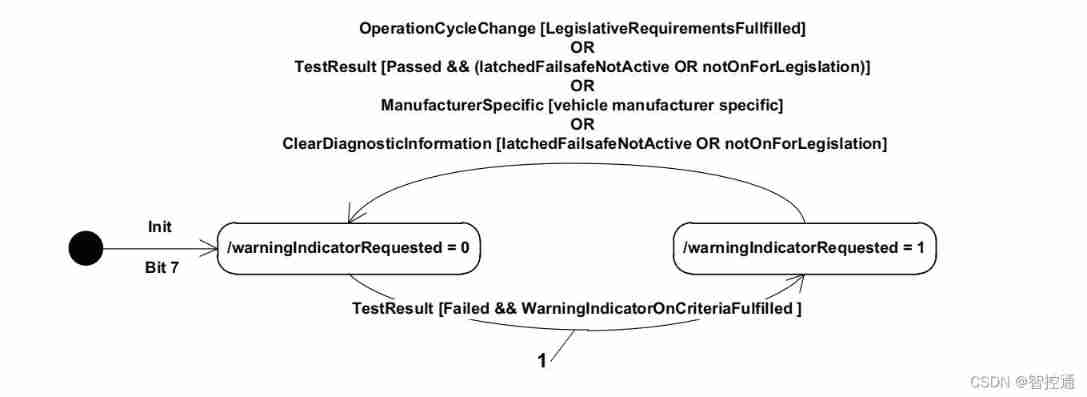
2.1.4DTC Status bit definition
This byte contains DTC The severity and DTC Information about .DTCSeverityMask/DTCSeeverity Bytes defined in the above table 1 Byte value report .1 Optional upper of byte value 3 position ( The first 7-5 position ) Used to represent DTC Severity information . If the server does not support , Then these bits should be set to “0”.1 Forced by byte value 5 position ( The first 4-0 position ) Used to represent DTC Class information .
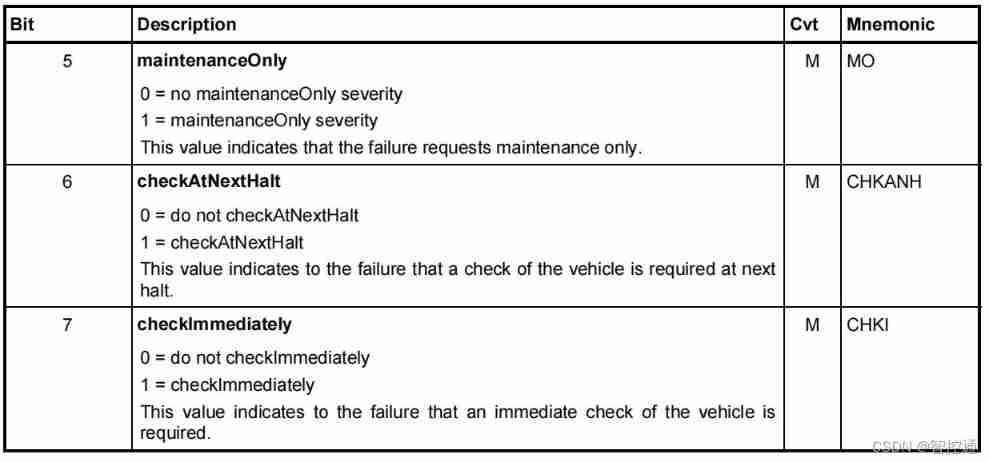
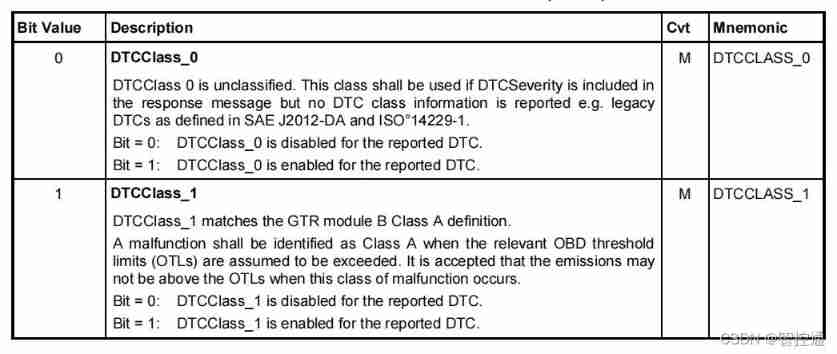
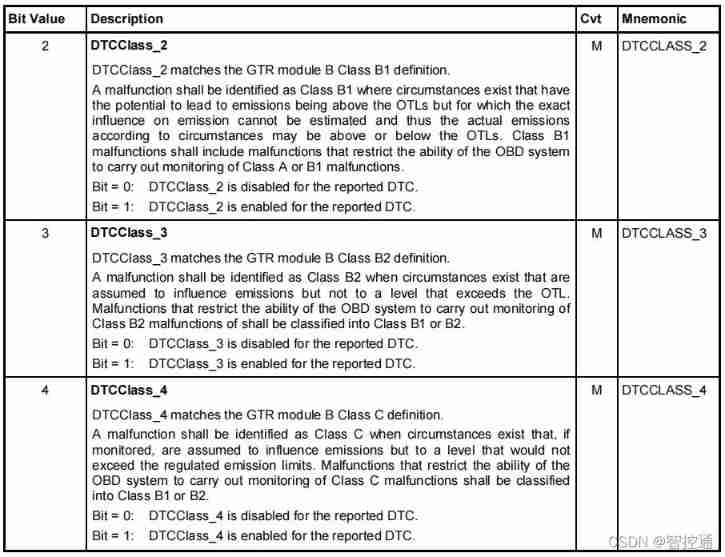
DTC The severity bit definition defines the bit state , To report the system ( E.g. vehicle ) Recommended actions to be taken by the operator . The table above defines DTC The severity status bit of .
2.1.5 DTC Format identifier definition
This parameter value defines the DTC The format of . A given server should only support one DTC Format identifier .
1. 0x00 SAE_J2012-DA_DTCFormat_00 : This parameter value identifies the server at ISO15031-6 Reported as defined in the specification DTC Format .
2.0x01 ISO_14229-1_DTCFormat : This parameter value identifies the parameters reported by the server DTC As defined in the table DTC Format .
3.0x02 SAE_J1939-73_DTCFormat: This parameter value identifies the value in SAEJ1939-73 Reported by the server defined in DTC Format .
4.0x03 ISO_11992-4_DTCFormat: This parameter value identifies the value in ISO11992-4 The server defined in the specification reports DTC Format .
5.0x04 SAE_J2012-DA_DTCFormat_04: This parameter value identifies the value in ISO27145-2 The server defined in the specification reports DTC Format .
6.0x05-0xFF ISO/SAE reserved: This document retains this value for future definition .
3. Clear diagnostic information (0x14) service
3.1 The service description
The client uses the clear diagnostic information service to clear the diagnostic information in the memory of one or more servers .
When the clear diagnostic information service completes processing , The server should send a positive response . Even if there is no storage dtc, The server should also send a positive response . If the server supports multiple in memory DTC A copy of the status information ( for example RAM A copy of and EEPROM A copy of ), The server should be cleared ReadDTC A copy used by the information status reporting service . Other copies , For example, backup copies in long-term memory , It will be updated according to the appropriate backup strategy ( For example, in the power latch phase ). If the power latch phase is disturbed ( for example , The battery is disconnected in the power latch phase ), This may lead to inconsistent data .
Reset through this service / Remove the DTC The information includes but is not limited to the following :
1.DTC Status bytes
2. The captured DTC Snapshot data
3. The captured DTC Extended data
4. other DTC related data , As first / Current DTC、 sign 、 Counter 、 Timers, etc . Specific to dtc Of
Stored in the server for optional use DTC Mirror any in memory DTC Information is not affected by this service .
3.2 The request message [ message ]
3.2.1 Request message definition

3.2.2 Request message subfunction parameters $Level(LEV_) Definition
This service does not use any subfunction parameters .
3.2.3 Request message data - Parameters are defined

3.3 Positive response
3.3.1 Positive response message definition

3.3.2 Supported negative response codes (NRC_)
The service should execute the following negative response code . The following table records what happens to each response code . If the error scenario applies to the server , The negative responses listed should be used .
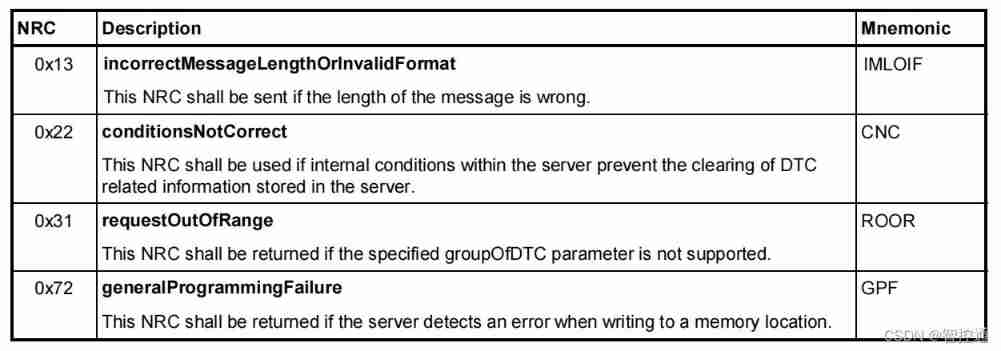
NRC Handle clear diagnostic information services
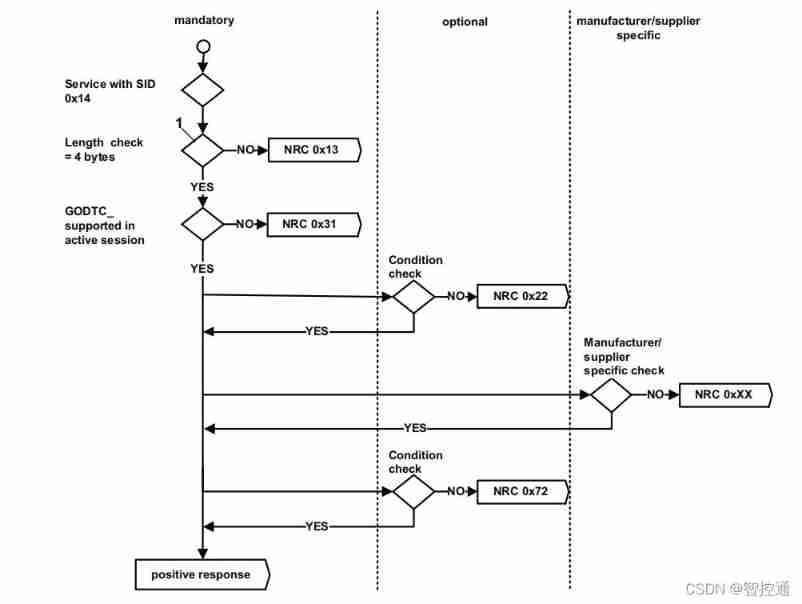
4. read DTC Information (0x19) service
4.1 The service description
This service allows the client to read the diagnostic fault codes residing in the server from any server or server group in the vehicle (DTC) The state of information . Unless otherwise required by specific subfunctions , The server should return all DTC Information ( for example , Emission related and non emission related ). This service allows clients to do the following :
1. Retrieve client defined DTC state The mask matches dtc Number .
2. Retrieve client defined DTC state Masks match all dtc A list of .
3. Retrieve matching client defined DTC state In a specific functional group of the mask dtc list .
4. Retrieve all with “ permanent DTC” State of dtc.
5. Retrieve client defined DTC The associated DTCs Snapshot data ( Sometimes called frozen frames ):DTC The snapshot is related to DTC Associated specific data records , They are stored in the memory of the server .DTC A typical use of snapshots is to store data when a system failure is detected .DTC The snapshot will be taken as a snapshot of the data value from the time of system failure . Stored in DTC The data parameters in the snapshot should be consistent with DTC Association .DTC Specific data parameters are designed to simplify the fault isolation process of technicians .
6. from DTC Memory or DTC The image is retrieved in memory and defined by the client DTC Data associated with the status mask combination . Data by and DTC The associated extended status information consists of . Data contains DTC Parameter values , They have been identified at the time of request . The typical use of data is to store and DTC Relevant dynamic data .
7.DTCB1 Malfunction indicator counter , Express OBD The time the system runs when the fault is activated ( Engine operating hours ).
8.DTC Occurrence counter , Count reported “ Test to fail ” Number of driving cycles .
9.DTC Aging counter , Count the number of driving cycles after the recent failure of the fault , Does not include tests not reported “ The test passed ” or “ Test to fail ” Driving cycle .
10.OBD Specific counters for ( for example , If the drive cycle can be performed in fault free mode , It's in “ Check the engine ” The number of drive cycles remaining before the lamp is turned off ).
11. The last time it happened ( etc. ).
12. Counter for test failure , Reported “ Test to fail ” And possibly other counters .
13. Unfinished test counter , Count the number of driving cycles since the test was recently completed ( namely , Due to test report “ The test passed ” or “ Test to fail ”).
14. Retrieve that matches the severity mask defined by the client dtc The number of .
15. Retrieve the that match the severity mask record defined by the client dtc list .
16. Retrieve client defined DTC Severity information .
17. Retrieve all supported by the server dtc The state of .
18. The first one that failed to retrieve the server DTC.
19. Retrieve the recently failed DTC.
20. Retrieve the first one confirmed by the server DTC.
21. Retrieve the recently confirmed DTC.
22. From... Defined with the client DTC The state mask matches DTC The image is retrieved from memory dtc list .
23. from DTC Retrieve client defined in the image memory DTC Mask and client defined DTC The data record data of the data record number of the extender .
24. From those that conform to the client definition DTC Status masked DTC Retrieve the matching in the image memory DTC Count .
25. Retrieve client defined DTC The state mask matches “ only ” Emission related OBDdtc The number of . Emission related OBDdtc This will cause the malfunction indicator to be turned on / Display a message .
26. Retrieve client defined DTC The state mask matches “ only ” Emission related OBDdtc The state of . Emission related OBDdtc This will cause the malfunction indicator to be turned on / Display a message .
27. Retrieve all that have been or have not been detected as “ undetermined ” or “ Confirmed ” The current “ Pre failure ”dtc.
28. from DTC In memory retrieval and client defined DTC Extended data records the data associated with the status .
29. From... Defined with the client DTC User defined that matches the state mask DTC Retrieve in memory dtc list .
30. From user-defined DTC Retrieve user-defined DTC Memory mask and client defined DTC Mask and client defined DTC Data record data .
31. From user-defined DTC Retrieve client defined DTC User defined mask DTC Recorded data in memory .
This service uses sub functions to determine the type of diagnostic information requested by the client . Further details on the parameters of each subfunction will be provided in the following sub clauses .
The following terms are used in this service :
1.Enable Criteria: The server / Vehicle manufacturer / System supplier specific standards , Used to control when the server actually performs specific internal diagnostics .
2.Test Pass Criteria: The server / Vehicle manufacturer / Specific conditions of the system supplier , Define whether a diagnosed system is normal 、 Normal operation within acceptable operating range ( for example , There is no fault , The system being diagnosed is classified as “ normal ”).
3.Test Failure Criteria: The server / Vehicle manufacturer / Specific fault conditions of the system supplier , Defines whether the diagnosed system fails the test .
4.Confirmed Failure Criteria: The server / Vehicle manufacturer / Specific fault conditions of the system supplier , It defines whether the system being diagnosed does have a problem ( Confirmed ), So as to ensure that DTC Records are stored in long-term memory .
5.Occurrence Counter: A counter maintained by some servers , It records the given DTC The only instance of test failure in the test report .
6.Aging: A process , Some of these servers evaluate the past results of each internal diagnosis , To determine what has been determined DTC Whether it can be cleared from long-term memory , for example , In the case of calibrated failure free cycles .
A given DTC value ( for example ,0x080511) Do not read on DTC The positive response of information is reported more than once , In addition to reading DTCC Snapshot records , The response may contain the same DTC The multiple DTCS Snapshot records .
When using page buffer processing to read diagnostic trouble codes ( Especially for subfunctions = The report DTCBy Status mask ), When creating a response , The number of diagnostic trouble codes may be reduced . under these circumstances , The response should be filled in DTC0x000000 and DTC state 0x00. Customers should take these dtc It is regarded as not present in the response message .
4.2 Retrieve that matches the state mask defined by the client DTC Count ( Subfunctions =0x01 The report number is = Status mask )
The client can set the subfunction to reportNumberOfDTCByStatusMask. The service of sends a request to retrieve the dtc The number of responses to this request contains DTCStatusAvailabilityMask,, It provides server supported for screening purposes DTC Indication of status bits . stay DTC After the state availability mask , Response includes DTC Format identifier , It reports about DTC Format and encoded information .DTC The format identifier is followed by DTCCount Parameters , This is a 2 Unsigned number of bytes , Available in server memory that contains a status mask based on the client DTC Number .
Subfunctions reportNumberOfMirrorMemoryDTCByStatusMask And subfunction reportNumberOfDTCByStatusMask It has the same function , The difference is that it returns DTC Image memory returns dtc The number of .
4.3 Retrieve that matches the state mask defined by the client dtc list ( Subfunctions =0x02 The report DTC Through the status mask )
The client can send a subfunction byte to set the status Mask the request to meet the status mask defined by the client . This subfunction allows clients to request server reports “ Test to fail ” or “ Confirmed as “ or ” And so on dtc.
The assessment should be as follows : The server should specify the mask in the client request with each supported by the server DTC Perform bit logic and operations between related actual states . except DTCStatusAvailabilityMask, outside , The server should also return all non-zero DTC( namely (DTC and DTC Status mask )!=0). If the client specifies a status mask containing bits that the server does not support , Then the server should only use the bits it supports to process DTC Information . If there is no dtc The matching masking condition is specified in the client request , Must not be in a positive response message DTC Any... Is provided after the status availability mask byte DTC Or status information .
Successfully sent on the client DTC When status diagnostic information is requested , Should be removed DTC State information ( Received in the server DTC Diagnostic information service request , About DTC Further description of status bit processing ,( See DTC Status bit definition ).
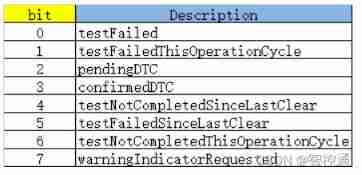
4.4 retrieval DTCS Snapshot record id ( Subfunctions =0x03 The report DTCS Snapshot ID )
The client can set the sub function to reportDTCSnapshotIdentification. Request for this service , To retrieve all captured DTCS Snapshot recorded DTCS The snapshot record identification information server should return all stored DTCS Snapshot recorded DTCS Snapshot record identification information list . The server is in a single DTCS Each item in the response message of the snapshot record should contain DTCRecord( contain DTC Number ( high 、 in 、 Low byte )) and DTCS Snapshot record number . If it is a single DTC Multiple... Are stored DTCS Snapshot records , Then the server should place an item in the response to each event , Use different for each event DTCS Snapshot record number ( Used to retrieve record data later ).
The server can support a single DTC Store multiple DTCS Snapshot records , To track every DTC Conditions that occur when they occur . Support this function 、“ happen ” Definition of standards and what to support DTCS The number of snapshot records shall be determined by the system supplier / Vehicle manufacturer to define .
Should be cleared according to the customer's successful request DTCS Snapshot record identification information . The vehicle manufacturer is responsible for specifying the deletion of storage overflows ( Memory space is completely occupied by storage Dtc and DTCS Snapshot data ) Time storage Dtc and DTCS Rules for snapshot data .
4.5 Retrieve client defined DTC Masked DTCS Snapshot record data ( Subfunctions =0x04 The report DTCSDTC Snapshot record number )
The client can set the subfunction to reportDTCSnapshotRecordByDTCNumber. This service request of , Defined for the client DTCMask Retrieve the captured... Together with the record number DTCS The snapshot recording data server should be in its supported dtc Search with client specified DTCMask Record ( contain DTC Number ( high 、 in 、 Low byte )) The exact match of . Provided in the client request DTCS The number of snapshot records parameter should specify that... Is being requested DTCS Designation of snapshot record data DTC Specific occurrence of .
DTCS Snapshot and record numbers do not share the same address space as data record numbers .
If the server supports single DTC Store multiple DTCS Snapshot records ( Support for this function will be provided by the system supplier / Vehicle manufacturer definition ), It is recommended that the server implement reportDTCSnapshotIdentification Subfunction parameters . It is recommended that the client first request to recognize the use of sub function parameters reportDTCSnapshotIdentification Stored DTCS Snapshot records , And then through reportDTCSnapshotRecordByDTCNumber Request request a specific DTCS Snapshot record number .
It is also recommended to support sub function parameters reportDTCSnapshotRecordIdentification, So that the client has the opportunity to directly identify the stored DTCS Snapshot records , Instead of all storage through the server dtc To analyze , To determine if DTCS Snapshot records .
System vendors / It is the responsibility of the vehicle manufacturer to define the DTCS Whether the snapshot record stores data related to the failure information , As ECU Part of the document .
If the client defines DTCMask Record and DTCS Snapshot records parameter (DTCSDTC And record number are not equal to 0xFF), The server should return a single predefined DTCS Snapshot records .
The exact fault criteria should be determined by the system supplier / The vehicle manufacturer determines .
DTCS Snapshot records may contain multiple data parameters , It can be used to reconstruct the vehicle condition when the fault occurs ( for example ,B+、RPM、 Time stamp ).
The vehicle manufacturer shall define the format and content of the data acquisition record . stay dtcs The data reported in the network record first contains a data identifier , To identify the following data . This data identifier / The data combination can be in dtcs Duplicate in snapshot record . stay DTCS The use of one or more data identifiers in the snapshot record allows different failures to occur DTC Store different types of DTCS Snapshot records . Every DTCS Snapshot records should provide a parameter , Instructions for each DTCS The number of record data identifiers contained in the snapshot record , To assist in data retrieval .
The server should report a DTCS Snapshot records , But the client has DTCS The number of snapshot records is set to 0xFF, Because this will cause the server to respond to the... Defined for the client in a single response message DTCMask Record all stored DTCS Snapshot records .DTC and n The status record is only included in the response message once . If the client in its request for parameters DTCS The number of snapshot records used 0xFF, Then the server should report as specific DTC All captured DTCS Snapshot records .
If the client specifies DTCMask Record or DTCS The network record number parameter is invalid or the server does not support , Then the server should respond negatively . This will be different from the client specified DTCMask Record and / or DTCS The snapshot records parameter is indeed valid and the server supports , But there is nothing associated with it DTCS Snapshot data ( for example , Because of the designated DTC Or the record number has never had a fault event ). The server should send only DTCand Status records ( Respond to the requested DTC Number ( high 、 in 、 Low byte ) and DTC state ) Positive response .
When the customer successfully requests to clear the diagnostic information , Should be removed DTCS Snapshot information . The vehicle manufacturer is responsible for specifying an overflow in memory ( Store in the server dtc and DTC Memory space of snapshot data ) Delete storage when dtc and DTCC Rules for snapshot data .
4.6 Retrieve the data record data of the record number defined by the client ( Subfunctions =0x05 The report DTC Stored data record number )
The client can set the sub function to reportDTCStoredDataByRecordNumber. Request for this service , To retrieve captured DTC The data server of the data record of the memory should search the dtc Store data records , To determine whether it matches the record number provided by the client .
DTC Storage number and DTCSNAP Does not share the same address space as the record number .
System vendors / It is the responsibility of the vehicle manufacturer to define the dtc Whether the storage data record stores data related to the first or recent failure .
The exact fault criteria should be determined by the system supplier / The vehicle manufacturer determines .
dtc The stored data record may contain multiple data parameters , It can be used to reconstruct the vehicle condition when the fault occurs ( Such as B+、RPM、 Time stamp ).
The vehicle manufacturer shall define dtc Format and content of memory and data logger numbers . The data reported in the data record first contains a data identifier to identify the following data . This data identifier / The data combination can be in dtc Duplicate in the stored data record . stay DTC The use of one or more data identifiers in stored data records allows for different failures to occur as one DTC Store different types of DTC Store data records . Each data storage data record should contain a parameter , Indicates the number of record data identifiers contained in each data store data record , To assist in data retrieval .
The server should report a DTC Memory data record , But the client has DTC The memory data record number is set to 0xFF, Because this will cause the server to respond to all... Stored in a single response message DTC Memory data record .
If the client requests to report all DTC Store data records , Must be repeated in each stored response message DTC Store data records .
If the client specifies dtc The memory data record number parameter is invalid or the server does not support , Then the server should make a negative response . This is really valid with the data record number parameter specified by the client and supported by the server , But there is no data associated with it. The situation of data recording is different ( for example , Because the specified record number has never had a fault event ). The server should send only DTC Positive response of memory data record number ( Positive response to the requested record number ).
The request to clear the diagnostic information according to the customer is successful , Data record information should be cleared . Vehicle manufacturer in case of memory overflow , It is responsible to specify that it has been stored DTC And delete rules for stored data .
4.7 Retrieve client defined DTC Mask and client defined DTC Data record data number of extended data ( Subfunctions =0x06 The report DTCExt Data records ByDTC Number )
The client can set the subfunction to reportDTCExtDataRecordByDTCNumber. This service request of , To retrieve the extension records defined by the client and DTC Extended data record number DTC The extended data server should be in its supported dtc Search with client specified DTCMask Record ( contain DTC Number ( high 、 in 、 Low byte )) The exact match of . under these circumstances , Provided in the client request DTC The extended data record number parameter should specify that... Is being requested DTC Specification of extended data DTC Specific to DTC Extended data record .
together with DTC Number and DTC state , The server should return a predefined DTC Extended data record , In response to client requests (DTCExt The data record number is not equal to 0xFE or 0xFF).
The vehicle manufacturer shall define DTC Format and content of export data record .DTCExt The structure of the data reported in the data record is determined by DTCExt Data record number definition , Its method is similar to the data definition in the record data identifier . The response may contain multiple DTCExt Data record number and related DTCExt Data records . Use one or more DTCExt The data record number can be a single DTC Store different types of DTCExt Data records .
The server should report a DTC Extended data record , But the client has DTCExtDAT The number of records is set to 0xFE or 0xFF, Because this will cause the server to respond to the... Defined for the client in a single response message DTC Extended records all data records stored .
If the client specifies DTCMask Record or DTCExt The data record number parameter is invalid or the server does not support , Then the server should make a negative response . This includes DTCExt The number of data records is 0xFE The situation of , But the server does not support OBD Extended data record (0x90-0xEF). This is the same as that specified by the client DTCMask Record and / or DTCExt The data record number parameter is indeed valid and supported by the server , But there is nothing associated with it DTC Extended data ( for example , Due to memory overflow of extended data ) The situation is different . If it is reportDTCExtDataRecordByDTCNumber, The server should send only DTC and n Status records ( Requested DTC Number ( high 、 in 、 Low byte ) and DTC state ) Positive response .
It is the responsibility of the vehicle manufacturer to specify the deletion of storage in case of memory overflow dtc and DTC Extended data storage dtc and DTC Rules of extended data .
4.8 Retrieve the that match the severity mask record defined by the client DTC Count ( Subfunctions =0x07 Size mark record of report number )
The client can set the subfunction to reportNumberOfDTCBySeverityMaskRecord. This service request of to retrieve the... That matches the severity mask record defined by the client dtc The data server should scan all supported dtc, The mask specified on the client is recorded with each stored DTC Perform bit level logical and chemical operations between the actual information of .
(((statusOfDTC & DTCStatusMask) != 0) && ((severity & DTCSeverityMask) != 0)) == TRUE
For every and operation that produces real results , The server should increase the counter 1. If the client specifies a status mask containing bits not supported by the server in the mask record , Then the server should only use the bits it supports to process DTC Information . Once you have checked all supported DTC once , The server will return to the client DTC Status availability mask , And return the resulting 2 Byte count .
If there is no dtc Match the shielding conditions specified in the client request , Then the count returned by the server to the client should be 0. Reported and DTC The state mask matches dtc The quantity is valid for the point in time when the request is made . Reported DTC Quantity and report through subfunction DTCBy Count the actual read DTC There is no relationship between lists , Because reading DTC Your request is completed at different points in time .
4.9 Retrieve the severity and functional unit information that matches the severity mask record defined by the client ( Subfunction =0x08 The report DTC Severity simulation record )
The client can retrieve DTC List of severity and functional unit information , Set the subfunction byte to reportDTCBySeverityMaskRecord. Request , To meet the severity mask record defined by the client, this subfunction allows the client to request the server to report all with a certain severity and status “ Test to fail ” or “ or ” Waiting dtc. The assessment should be carried out as follows :
The server should specify in the client request DTCS Level mask and actual DTC State mask and each supported by the server DTC Associated reality DTCS Perform bit level logical summation between levels and States .
except DTCStatusAvailabilityMask, Outside the server , Should return all with operation result true dtc Outside .
4.10 Retrieve client defined DTC Severity and functional unit information ( Subfunction =0x09 Report serious information )
The client can set the subfunction to reportSeverityInformationOfDTC. To retrieve the client defined DTCMask The severity and functional unit information server should be recorded in the dtc Search with client specified DTCMask Record ( contain DTC Number ( high 、 in 、 Low byte )) The exact match of .
The client can send a request for this service , And set the subfunction to report “ Supported dtc”, To retrieve all supported by the server dtc The state of . The response to this request contains DTCStatusAvailabilityMask,, It provides server supported for screening purposes DTC Indication of status bits . stay DTC After the state availability mask , The response also contains DTC And status record list , It contains... For each diagnostic trouble code supported by the server DTC Number and related status .
4.11 Retrieve for the first time / Recently failed DTC( Subfunction =0x0B Report the first failure DTC, Subfunction =0x0D Report current faults DTC)
The client can set the subfunction byte to “ The report DTC” or “ The report ” Request , Retrieve the first... From the server / Recently failed DTC. And DTCStatusAvailabilityMask, Together , The server should send the first or most recently failed DTC Number and related status are returned to the client .
If no fault has been recorded since the client last requested the server to clear the diagnostic information DTC, Should not be in the positive response message DTC Status availability bytes are provided after DTC/ State information . Besides , If since the last time the client requested the server to clear diagnostic information , only one DTC Failure , Then a failed DTC Will return to the first report and from the client reportMostRecentTestFailedDTC request .
for the first time / Recent failures DTC Records of should be independent of confirmation dtc Aging process .
As mentioned above , Send a successful DTC When requesting diagnostic information , The first / Recently failed DTC Information ( Received in the server DTC Diagnostic information service request DTC Status bit definition , Please see the D.2 About China DTC Further description of status bit processing ).
4.12 Retrieve the first / Recently detected confirmed DTC( Subfunction =0x0C The report first confirms DTC, Subfunction =0x0E The report first confirmed recently DTC)
The client can set the subfunction byte to “ The report confirms for the first time ” Request , Retrieve the first... From the server / Recently confirmed DTC. And DTCStatusAvailabilityMask, Together , The server should return the first or most recently confirmed DTC Number and related status to the client .
If no confirmed... Has been recorded since the client last requested the server to clear the diagnostic information DTC, Should not be in the positive response message DTC Status availability is provided after masking bytes DTC/ State information . Besides , If since the last time the client requested the server to clear diagnostic information , Only 1 individual DTC Be confirmed , Then a confirmed DTC The first confirmation of the report from the client will be returned DTC and reportMostRecentConfirmedDTC request .
First confirm DTC Records of should be kept in DTC Failed past , But then the client that meets the time request before the aging standard ( Whatever else dtc Become the confirmation of the above DTC Become a confirmation ). Again , Recently confirmed DTC Records of should be kept in the past for confirmation , But then meet the aging standard before the customer's request ( Suppose there is nothing else dtc In the above DTC Be confirmed after failure ).
As mentioned above , When the customer makes a successful request for clear diagnostic information , The first / Recently confirmed DTC Information .
4.13 From the server that matches the state mask defined by the client DTC The image is retrieved from memory dtc list ( Subfunctions =0x0F The report m Mirrored memory is masked by state )
Subfunctions reportMirrorMemoryDTCByStatusMask Processing and reporting DTC The state mask of is defined in the same way , Except for all state mask checks, they are stored on the server DTC Mirror in memory DTC Executive .DTC Mirrored memory is another optional error memory in the server , Clear diagnostic information (0x14) The service cannot erase it .DTC The image memory image is normal DTC Memory , Normal error memory can be used .
4.14 from DTC Retrieve client defined in the image memory DTC Mask and client defined data record data ( Subfunctions =0x10reportMirrorMemoryDTCExtDataRecordByDTCNumber)
Subfunctions reportMirrorMemoryDTCExtDataRecordByDTCNumber The processing and of is reportDTCExtDataRecordByDTCNumber, The defined processing is the same , Only the data is from DTC Retrieved from the image memory .DTC Mirrored memory is another optional error memory in the server , Clear diagnostic information (0x14) The service cannot erase it .DTC The image memory image is normal DTC Memory , Normal error memory can be used .
4.15 Retrieve the mirrored memory that matches the state mask defined by the client DTC Count ( Subfunctions =0x11 The report number is mirrored memory DTC Through the status mask )
The client can set the subfunction to reportNumberOfMirrorMemoryDTCByStatusMask. To retrieve the mirrored memory that matches the state mask defined by the client dtc The count of quantities the response to this request contains DTCStatusAvailabilityMask,, It provides server supported for screening purposes DTC Indication of status bits . stay DTC After the state availability mask , Response includes DTC Format identifier , It reports about DTC Format and encoded information .DTC The format identifier is followed by DTCCount Parameters , This is a 2 Unsigned number of bytes , According to the status mask provided by the client, it contains the... Available in the server memory DTC Number .
4.16 Retrieve that matches the state mask defined by the client “ Emission related only OBD” Number of diagnostic trouble codes ( Subfunction =0x12 Report no. emission value obDDTCBy Status mask )
The client can set the subfunction to reportNumberOfEmissionsOBDDTCByStatusMask. This service request of , Retrieve that matches the state mask defined by the client “ Emission related only OBD”dtc The response to this request contains DTCStatusAvailabilityMask,, It provides server supported for screening purposes DTC Indication of status bits . stay DTC After the state availability mask , Response includes DTC Format identifier , It reports about DTC Format and encoded information .DTC The format identifier is followed by DTCCount Parameters , This parameter is a 2 Unsigned number of bytes , It contains a state mask based on the client , Available in server memory “ Emission related only OBD”DTC The number of .
4.17 Retrieve that matches the state mask defined by the client “ Emission related only OBD”dtc list ( Subfunction =0x13 The report - launch sOBDDTCBy Status mask )
The client can retrieve a “ Emission related only OBD”dtc list , They set the subfunction byte to reportEmissionsOBDDTCByStatusMask. This subfunction allows the client to request the server to report all “ Test to fail ” or “ confirm ”“ or “ Waiting OBD”dtc. The assessment should be carried out as follows : The server should specify the mask in the client request with each supported by the server “ Emission related OBD”DTC Perform bit level logical and chemical operations between related actual states . except DTCStatusAvailabilityMask, Outside , The server should also return all zeros “ Emission related OBD”DTC( namely (DTC and DTC Status mask )!=0). If the client specifies a status mask containing bits that the server does not support , Then the server should only use the bits it supports to process DTC Information . If there is no “ Emission related OBD”DTC Match the shielding conditions specified in the client request , Should not be in the positive response message DTC The status availability mask byte provides any DTC Or status information .
Send a successful DTC When requesting diagnostic information , Should be removed “ Emission related OBD”DTC State information ( Received in the server DTC Diagnostic information service request DTC Status bit definition .
4.18 retrieval “ Pre failure ” Of DTC Status list ( Subfunctions =0x14 The report -dtc Fault detection counter )
The client can retrieve all current “ Pre failure ”dtc A list of , these dtc It has been detected as “ Hang up ” or “ confirm ”.DTC The purpose of the fault detection counter is a simple method , Can identify a specific DTC The state of is unrecognized / Read DTC Byte growth or intermittent problems . The internal implementation of the fault detection counter shall be specific to the vehicle manufacturer .“ Pre failure ”dtc The use case of is to speed up fault detection during testing in the manufacturing plant , This requires unacceptable maturity time for manufacturing tests . After repairing or installing new components , Services have similar use cases .
4.19 Retrieve with “ permanent DTC” State of DTC list ( Subfunction =0x15 The report - Having a permanent state DTC)
The client can retrieve “ permanent DTC” State of dtc list .
4.20 Retrieve client defined DTC Data record data of extended data record number ( Subfunctions =0x16 The report DTCExt Data records are numbered according to records )
The client can set the subfunction to reportDTCExtDataRecordByRecordNumber. Send a request for this service , Retrieve client defined DTC The extended data record number server should search all supported dtc, To determine the relationship with the client specified DTCExt Accurate matching of data record numbers . under these circumstances , Provided in the client request DTCExt The data record number parameter should be all supported... Being requested DTC Specify a specific DTC Extended data record .
The server should return a DTC Extended data record , And each supported DTC Of DTC Number and status , It contains the requested DTCExt Data of data record number .
The vehicle manufacturer shall define DTC Format and content of export data record .DTCExt The structure of the data reported in the data record is determined by DTCExt Data record number definition , Its method is similar to the data definition in the record data identifier .
If the client specifies DTCExtData The number of records parameter is invalid or the server does not support it , Then the server should respond negatively .
Provisions for clearing data information when receiving and determining diagnostic information service . It is the responsibility of the vehicle manufacturer to specify the deletion of storage in case of memory overflow dtc and DTC Extended data storage dtc and DTC Extended data ) The rules of .
4.21 Retrieve from the functional group that matches the state mask defined by the client WWH-OBDdtc list ( Subfunctions =0x42 The report -WWHOBDDTCByMaskRecord)
Mask ( With severity and level ) The implementation and use of ISO°27145-3[17] In the definition of .
4.22 Retrieve with “ permanent DTC” State of WWH-OBDDTC list ( Subfunction =0x55 The report -WWHOBDDTC Have a permanent state )
The client can retrieve information with “ permanent DTC” State of WWH-OBDdtc list .
4.23 User defined from the server DTC In memory retrieval and client defined DTC Status mask matching dtc list ( Subfunctions =0x17 Report user deletion DTC Through the status mask )
The client can retrieve from user-defined memory dtc list , It sets the subfunction byte to reportUserDefMemoryDTCByStatusMask. This subfunction allows the client to request the server to report all “ Test to fail ” or “ Confirmed as “ or ” Waiting dtc. From user-defined memory .
The assessment should be carried out as follows : The server should specify the mask in the client request and each supported by the server in the user-defined memory DTC Perform bit level logical and chemical operations between related actual states . except DTCStatusAvailabilityMask, outside , The server should also return a non-zero result of the operation in this specific memory ( namely ( state DTC and DTC Status mask )!=0) All of the DTC. If the client specifies a status mask containing bits that the server does not support , Then the server should only use the bits it supports to process DTC Information . If there is no DTC Match the shielding conditions specified in the client request in this specific memory , Should not be in the positive response message DTC The status availability mask byte provides any DTC Or status information .
DTC The status information should not be cleared at the successful request of the customer , Instead, it should be cleared by the manufacturer's specific routine control .
4.24 from DTC Retrieve client-defined from user-defined memory DTC Mask and client defined DTCS Snapshot record data ( Subfunctions =0x18reportUserDefMemoryDTCSnapshotRecordByDTCNumber)
The client can set the subfunction to reportUserDefMemoryDTCSnapshotRecordByDTCNumber. This service request of , Retrieve client defined DTCS Snapshot record number and user-defined DTCS The snapshot recording data server should be in its supported dtc Search with client specified DTCMask Record ( contain DTC Number ( high 、 in 、 Low byte )) The exact match of . Provided in the client request DTCS The snapshot record number parameter should specify DTC Specific occurrences and requests DTCS Defined memory for snapshot record data .
DTCS Snapshot and recorder numbers are the same as DTC Memory and data logger numbers do not share the same address space .
System vendors / It is the responsibility of the vehicle manufacturer to define the DTCS Whether the snapshot record stores data related to the first or recent failure .
If defined for the client DTC, The server should return a predefined DTCSNES Record number parameters and DTCS Failure of , In response to client requests .
The exact fault criteria should be determined by the system supplier / The vehicle manufacturer determines .
DTCS Snapshot records may contain multiple data parameters , It can be used to reconstruct the vehicle condition when the fault occurs ( for example ,B+、RPM、 Time stamp ).
The vehicle manufacturer shall define DTCS Format and content of snapshot record ( namely DTCS The contents of snapshot records may be different memory records ) Format and content of . stay dtcs The data reported in the network record first contains a data identifier , To identify the following data . This data identifier / The data combination can be in dtcs Duplicate in snapshot record . Use in user-defined memory DTCS One or more data identifiers in the snapshot record allow for different failures DTC Store different types of DTCS Snapshot records . Every DTCS Snapshot records should provide a parameter , Instructions for each DTCS The number of record data identifiers contained in the snapshot record , To assist in data retrieval .
The server should report a DTCS Snapshot records , But the client has been set DTCS The number of snapshot records is 0xFF, Because this will cause the server to respond to all defined by the client DTCS Snapshot records and user-defined response messages .DTC and n The status record is only included in the response message once .
If the client specifies DTCMask Record 、DTCS Online photo record number 、 Invalid user memory parameter or server does not support , The server should respond negatively . This is different from DTCMask Record and / or DTCS The client specified by the snapshot records parameter is indeed valid and the server supports specific memory , But there is no correlation DTCS Snapshot data ( for example , Due to the failure event, the specified DTC Or record the number ). The server should send only DTCand Status records ( Requested DTC Number ( high 、 in 、 Low byte ) Echo of plus DTC The state of ) Positive response .
DTCS The snapshot information should be based on the manufacturer's specific conditions proposed by the customer ( Such as routine control ) Requires removal . It is the responsibility of the vehicle manufacturer to specify the deletion of storage in case of storage overflow Dtc and DTCS Storage of snapshot data Dtc and DTC Rules for snapshot data .
4.25 Retrieve user-defined in memory client defined DTC Mask and client defined data record data ( Subfunctions =0x19reportUserDefMemoryDTCExtDataRecordByDTCNumber)
The client can set the subfunction to reportUserDefMemoryDTCExtDataRecordByDTCNumber. This service request of , Retrieve the data defined by the client 、DTC Extended data record number and user's DTC The extended data server should be in its supported dtc Search with client specified DTC Record ( contain DTC Number ( high 、 in 、 Low byte )) Exact match with the user's memory identifier . under these circumstances , Provided in the client request DTC The extended data record number parameter should specify that... Is being requested DTC Specification of extended data DTC Specific to DTC Extended data record .
except DTC Number and DTC state , The server should return a predefined DTC Extended data record , In response to client requests (DTCExt The data record number is not equal to 0xFE or 0xFF).
The vehicle manufacturer shall define the format and content of user-defined data records .DTCExt The structure of the data reported in the data record is defined by a specific user-defined memory , Its method is similar to the data definition in the record data identifier . The response may contain multiple DTCExt Data record number and related DTCExt Data records . Use one or more DTCExt The data record number can be a single DTC Store different types of DTCExt Data records .
The server should report a DTC Expand D Data records , In addition to client settings DTCExT Data record number 0xFE or 0xFF, Because this will cause the server to respond to all DTC The user-defined memory of the extended data record is stored in a response message .
If the client specifies DTCMask Record or DTCExtData The number of records parameter is invalid or the server does not support it or is not in this specific memory , Then the server should respond negatively . This is the same as that specified by the client DTCMask Record and / or DTCExt The data record number parameter is indeed valid and supported by the server , But there is nothing associated with it DTC Extended data ( for example , Due to memory overflow of extended data ) The situation is different . If it is reportDTCExtDataRecordByDTCNumber, The server should send only DTC and n Status records ( Requested DTC Number ( high 、 in 、 Low byte ) and DTC state ) Positive response .
It is the responsibility of the vehicle manufacturer to specify that stored dtc and DTC Rules of extended data .
4.26 The request message [ message ]
4.26.1 Request message definition
Read according to the sub function parameter definition used dtc Structure of information request message

Read according to the sub function parameter definition used dtc Structure of information request message
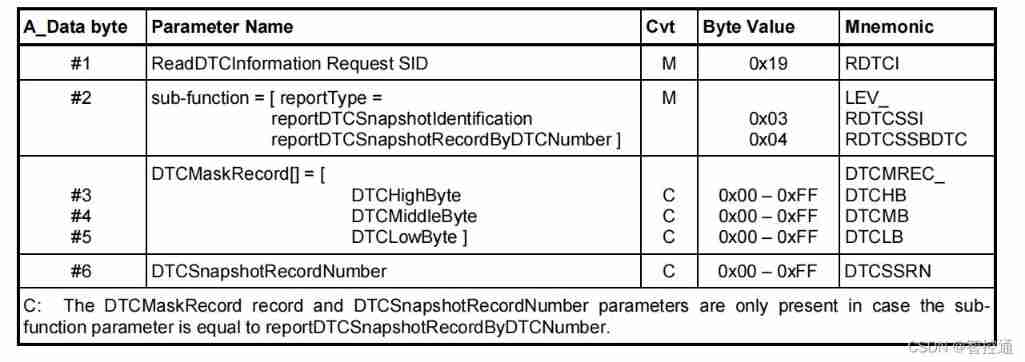
Read according to the sub function parameter definition used dtc Structure of information request message

Read according to the sub function parameter definition used dtc Structure of information request message

Read according to the sub function parameter definition used dtc Structure of information request message

Read according to the sub function parameter definition used dtc Structure of information request message

Read according to the sub function parameter definition used dtc Structure of information request message

Read according to the sub function parameter definition used dtc Structure of information request message

Read according to the sub function parameter definition used dtc Structure of information request message

Read according to the sub function parameter definition used dtc Structure of information request message

Read according to the sub function parameter definition used dtc Structure of information request message

Read according to the sub function parameter definition used dtc Structure of information request message

Read according to the sub function parameter definition used dtc Structure of information request message
 4.26.2 Request message subfunction parameters $Level(LEV_) Definition
4.26.2 Request message subfunction parameters $Level(LEV_) Definition
This service uses sub function parameters to select the DTC One of the report types . The explanation and use of possible levels are detailed below ( Inhibition p Indicator bit ( position 7) Not shown ).
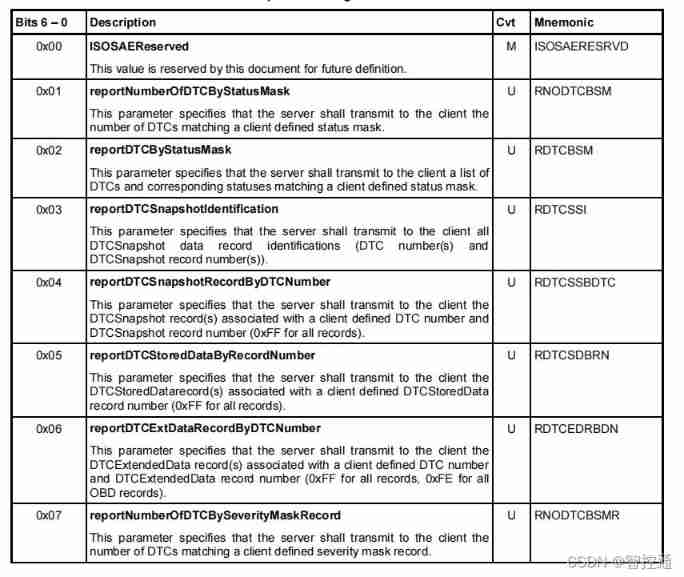
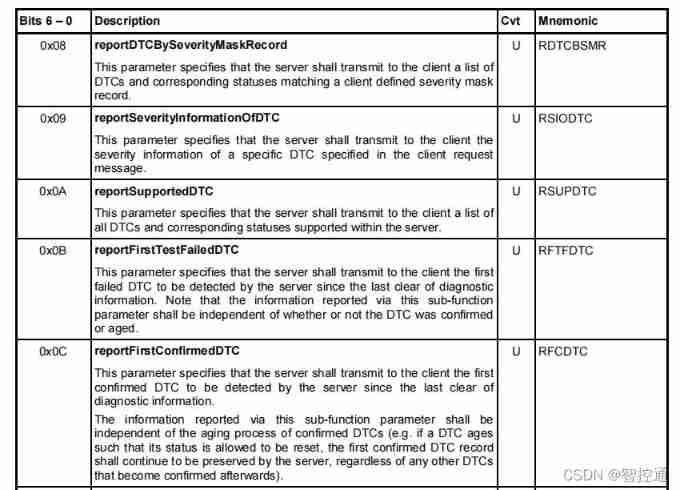
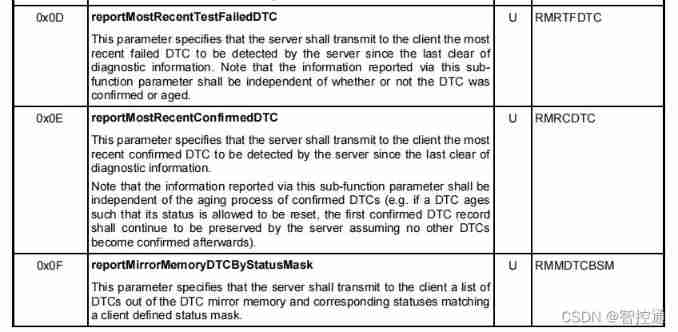
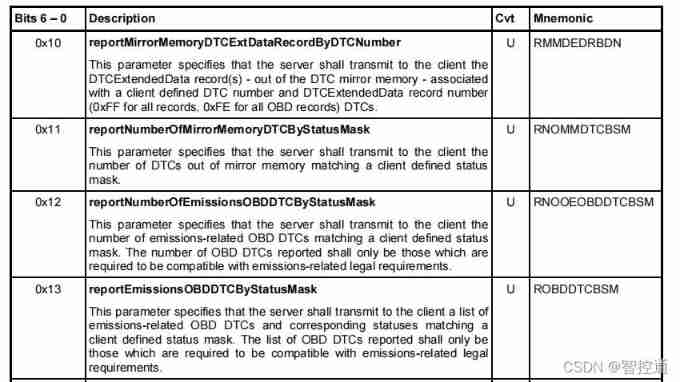
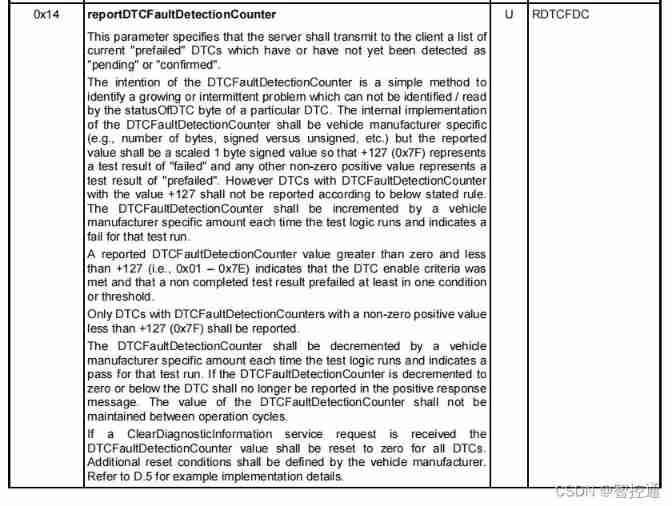
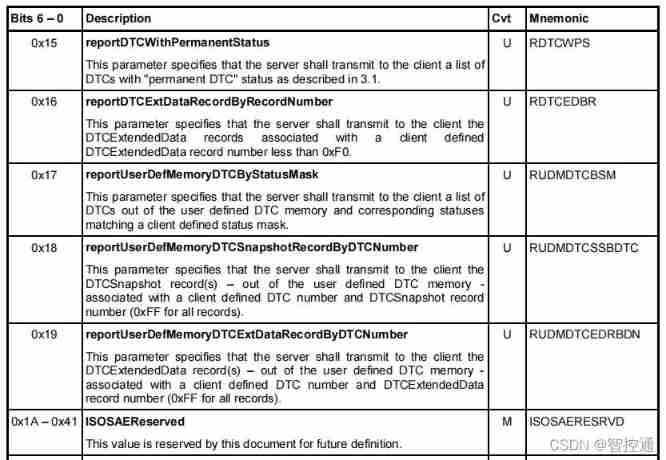
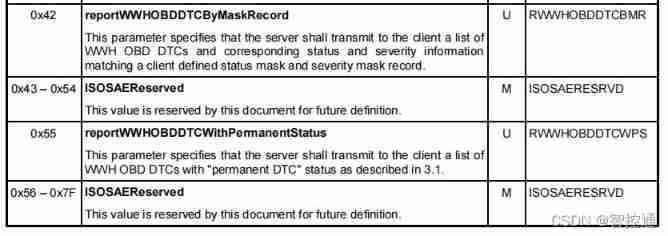
4.26.2 Request message data - Parameters are defined
4.26.2.2 DTCMaskRecord [DTCHighByte, DTCMiddleByte, DTCLowByte]
DTCMaskRecord It's a 3 Byte value , contain DTC High byte 、DTCMiddlebyte Bytes and low bytes , Together, they represent the unique identification number of the specific diagnostic trouble code supported by the server .3 byte DTC The definition of number allows encoding in several ways DTC Information . Both of these can be done
1. according to ISO15031-6[12] standard , Use DTC High byte 、DTC Medium byte 、 Middle byte and DTCLow Decode bytes . This format is provided by DTC Format identifier =SAE_J2012-DA_DTCFormat_00 identification .
2. By reference to ISO14229 This part of uses DTCHighebyte and DTCLowByte The decoding , This section does not specify any decoding method , Therefore, the decoding method defined by the vehicle manufacturer is allowed . This format is provided by DTC Format identifier =ISO_14229-1_DTCFormat identification .
3. according to SAEJ1939-73[19] standard , Yes DTC High byte 、 Numeric bytes 、 Middle byte and DTCLow Decode bytes . This format is provided by DTC Format identifier =SAE_J1939-73_DTCFormat identification .
4. according to ISO11992-4[5] standard , Use DTC High byte 、DTC Medium byte 、 Middle byte and DTCLow Decoding of bytes . This format is provided by DTC Format identifier =ISO_11992-4_DTCFormat identification .
5. according to ISO27145-2[16] standard , Use DTC High byte 、DTC Medium byte 、 Middle byte and DTCLow Decode bytes . The format consists of DTC Format identifier =SAE_J2012-DA_WWH-OBD_DTCFormat identification .
4.26.2.3 DTCSnapshotRecordNumber
DTCS The number of snapshot records is one 1 Byte value , Indicate through reportDTCSnapshotByDTCNumber The subfunction is defined for the client reportDTCSnapshotByDTCNumber Specific to the data record request DTCS Number of snapshot data records .DTCS Snapshot data record number 0x00 It should be retained for legislative purposes ( for example ,WWH-OBD). stay 0x01 to 0xFE Within the scope of DTCS Snapshot records shall be available for specific use by the vehicle manufacturer . The value is 0xFF, Request the server to report all stored DTCS Snapshot data record .
4.26.2.4 DTCStoredDataRecordNumber
DTC The number of stored data records is one 1 Byte value , Indicate through reportDTCStoredDataByRecordNumber The specific request of the subfunction DTC Number of stored data records .0x00 Apply to legal purposes .dtc Memory in 0x01 To 0xFE Data records within the scope shall be available for the specific use of the vehicle manufacturer . value 0xFF Request the server to report all stored dtc Store data records .
4.26.2.5 DTCExtDataRecordNumber
DTCExt The number of data records is one 1 Byte value , Indicate through reportDTCExtDataRecordByDTCNumber and reportDTCExtDataRecordByRecordNumber The subfunction is specific to the data record request defined by the client DTC Number of extended data records . For emission related servers ( And OBD Compatible ECUs), Should be retained DTCExt Data record number 0x00, For the future OBD Use . Keep the following DTCExtData Record number range :
1.SO/SAE The reserved value is 0x00.
2. value 0x01-0x8F Request the server to report vehicle manufacturer specific stored DTCExtended Data records .
3. value 0x90-0xEF Request the server to report legislation OBD Stored DTC Extended data record .
4.ISO/SAE Retain the 0xF0-0xFD Value , Used to report groups in a single response message in the future .
5. value 0xFE Request the server to report all legislation in a single response message OBD Stored DTC Extended data record .
6. value 0xFF Request the server to report all stored DTCexd Data records .
4.26.2.6 DTCSeverityMaskRecord [DTCSeverityMask, DTCStatusMask]
Status record is a 2 Byte value , contain DTCSeveverity Mask and DTC Status mask ( See the document above ).
4.26.2.7 DTCSeverityMask
DTCS The importance level mask contains three DTC Severity bit . The definition of each of these three bits can be found in the above document . This byte is used in the request message , Allow clients to define and for their severity DTCS The data mask of level matches dtc request DTC Information . If any one DTC The actual severity bit is set to “1”, also DTCSA The corresponding severity bit in is also set to “1”( for example , If DTCS The actual severity bit logic matches , And DTC The actual severity result is non-zero , Then a match occurs ).
4.26.2.8 FunctionalGroupIdentifier
Functional group identifiers are introduced to distinguish between many different ecu Commands sent by test equipment between different functional system groups in the electrical architecture . If one ECU The software of the emission system has been implemented, and others may be in I/M The system checked during the test , You must report only the DTC Information .I/M The test should not be stored because of another functional system group DTC Information and failure . The function group identifier is specified in the function group identifier definition .
4.27 Positive response message
4.27.1 Positive response message definition
Right service ReadDTC Positive response to information requests ) It depends on the sub functions in the service request .
Define the positive response message format of sub function parameters
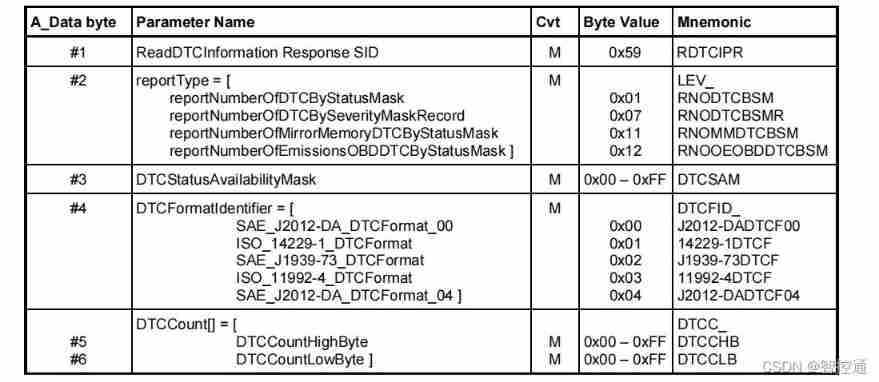
Define the positive response message format of sub function parameters
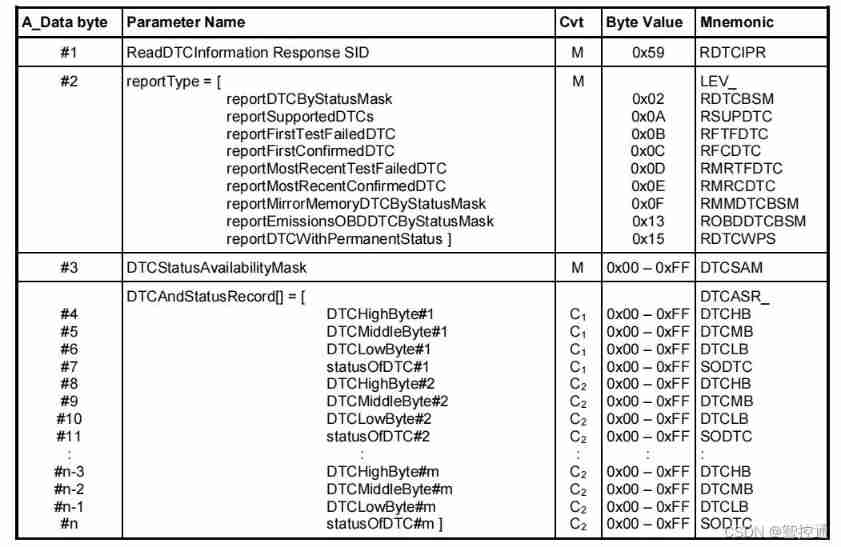
 Define the positive response message format of sub function parameters
Define the positive response message format of sub function parameters
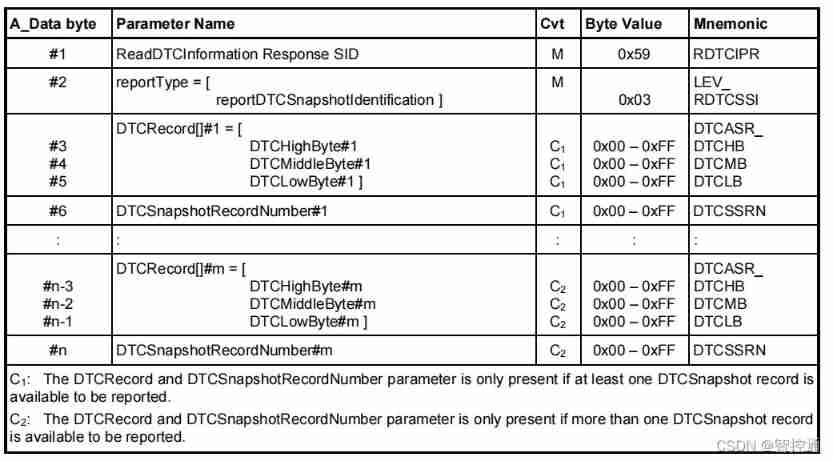
Define the positive response message format of sub function parameters

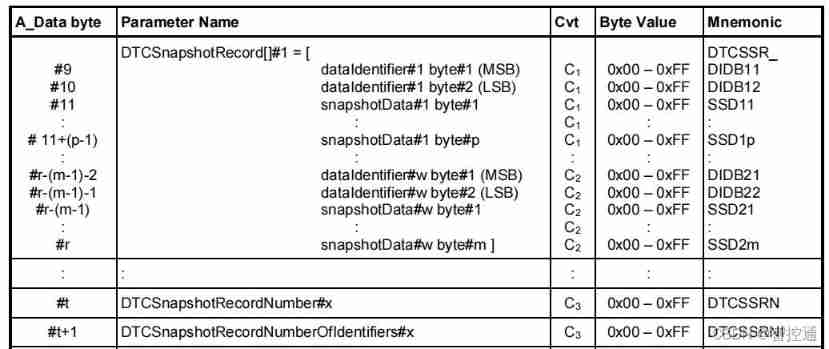
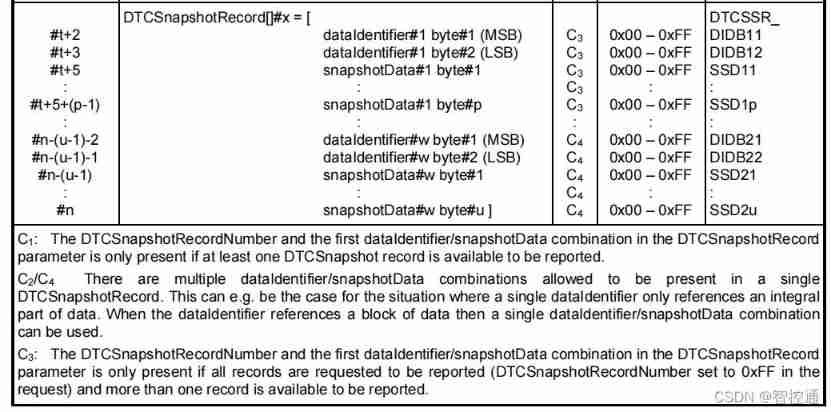
Define the positive response message format of sub function parameters

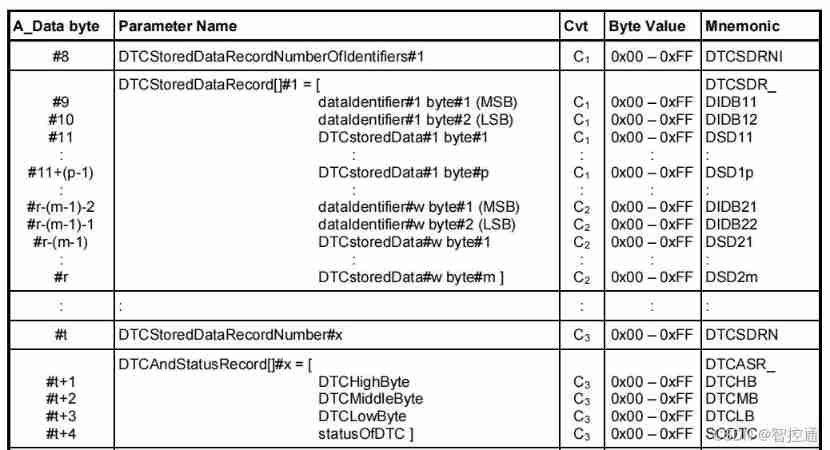
 Define the positive response message format of sub function parameters
Define the positive response message format of sub function parameters
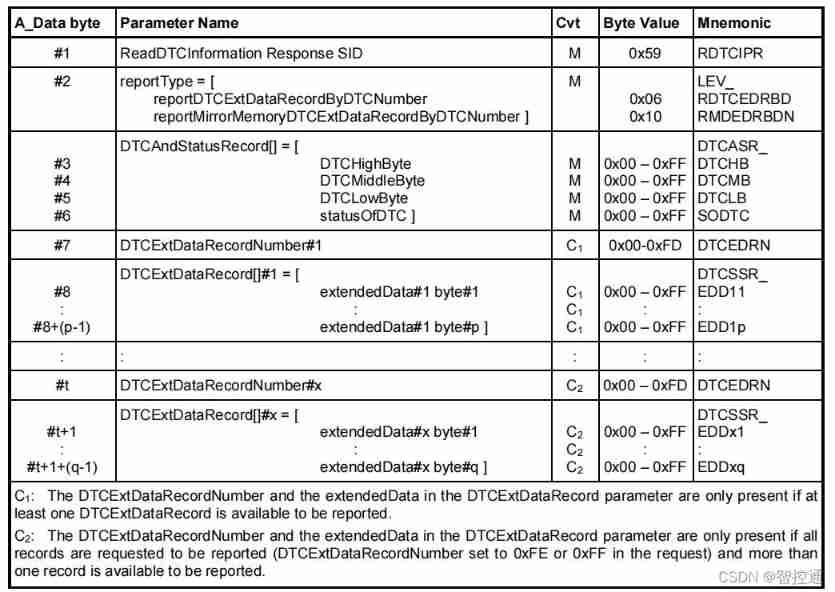
Define the positive response message format of sub function parameters

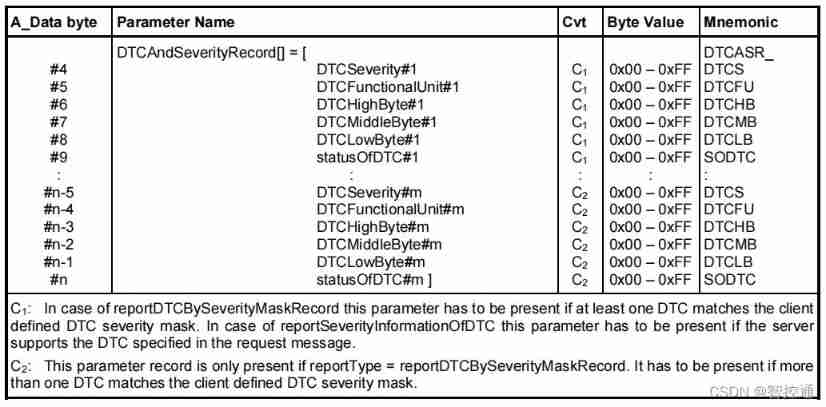
Define the positive response message format of sub function parameters
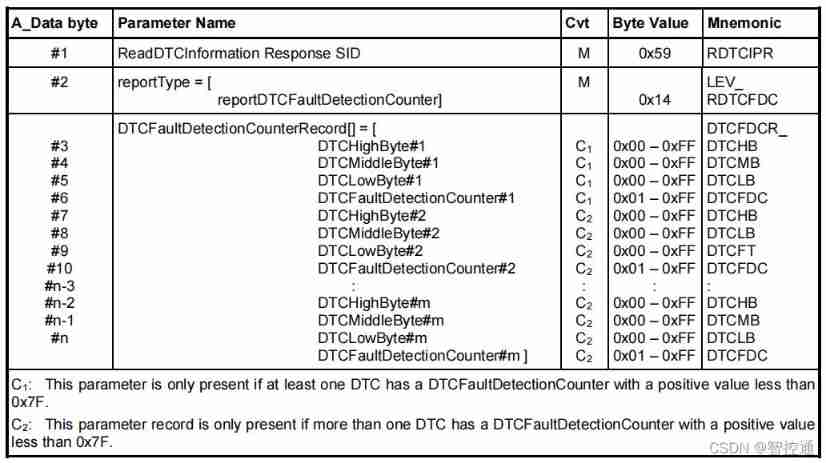
Define the positive response message format of sub function parameters
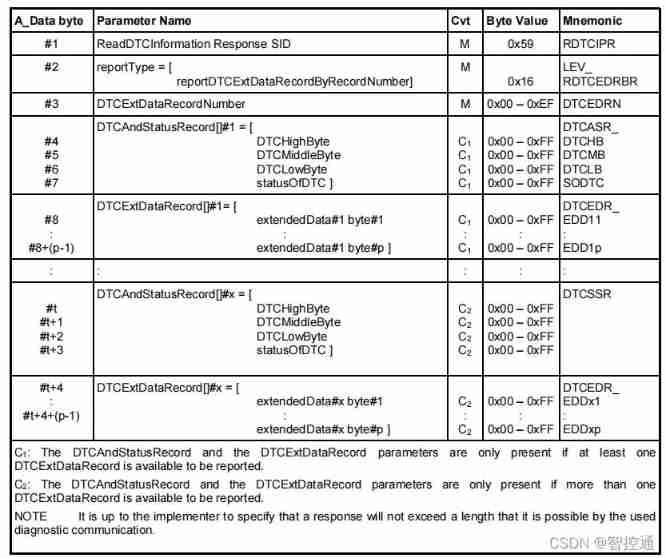
Define the positive response message format of sub function parameters

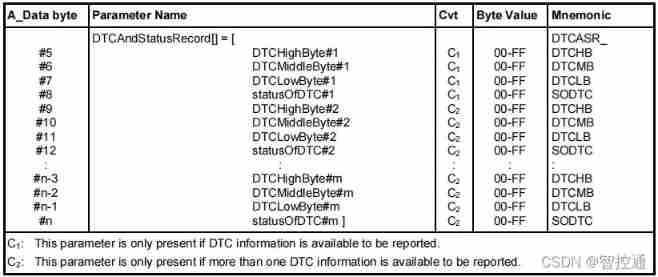 Define the positive response message format of sub function parameters
Define the positive response message format of sub function parameters
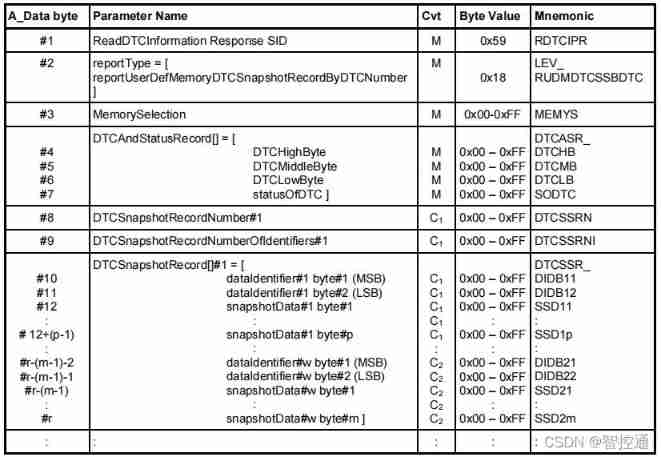
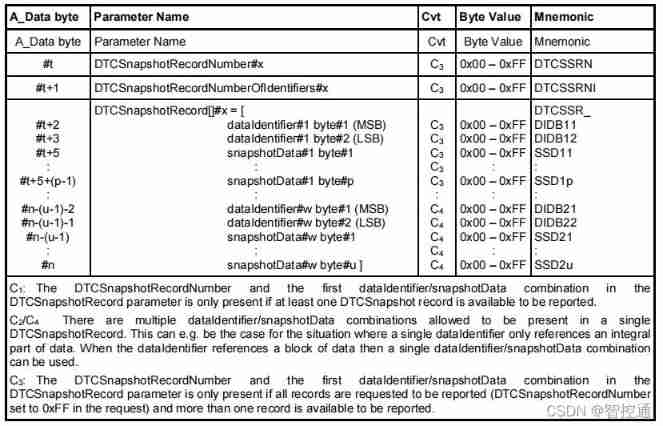 Define the positive response message format of sub function parameters
Define the positive response message format of sub function parameters
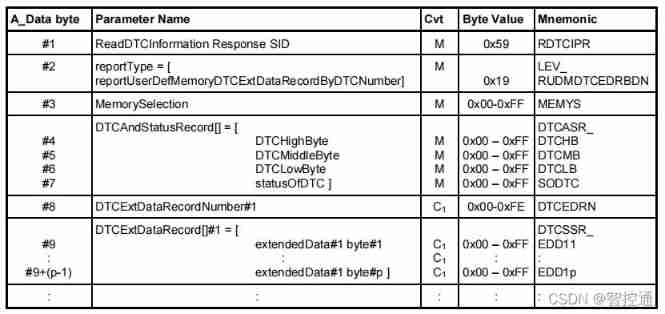

Define the positive response message format of sub function parameters
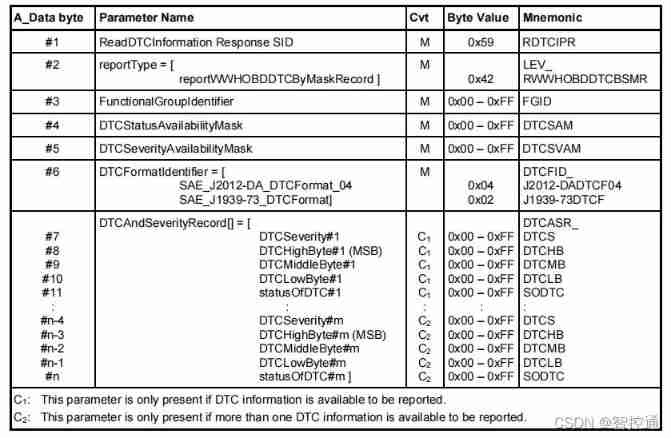
Define the positive response message format of sub function parameters
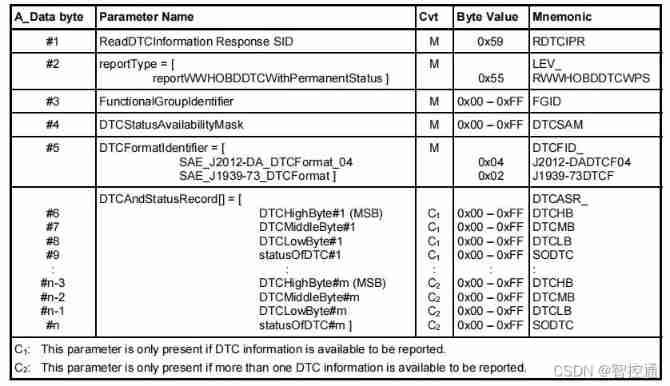
4.27.2 Positive response message data parameter definition
4.27.2.1 reportType
This parameter is the number of sub function parameters provided in the request message from the client 6-0 Bit mapping .
4.27.2.2 DTCAndSeverityRecord
This parameter record contains SAE_J2012-DA_DTCFormat_00、D-1_DTCFormat、DTC Functional units 、SAE_J2012 byte 、SAE_J1939-73_DTCFormat)、DSO11992-4DTC Format or SAE_J2012-DA_DTCFormat_04 One or more groups of .
The fault control level identifies the impact of the fault on vehicle operation and / Or the importance of system functions , It also allows the suggested operation to be displayed to the driver .dtcs For the definition of severity, see D.3.DTC The functional unit is a 1 Byte value , It identifies the report DTC Corresponding basic vehicle / system function .DTC The definition of functional unit is implemented , It shall be specified in their respective implementation standards .
DTCHighhByte、DTCMiddleByte and DTCLowByte Together, the unique identification number of the specific diagnostic trouble code supported by the server .DTCHighh Byte and DTCMiddle Bytes indicate the circuit or system being diagnosed .DTCLowByte Indicates the type of fault in the circuit or system ( for example , The sensor is open 、 The sensor is short circuited to ground 、 Algorithm based faults, etc ). This definition can be found in ISO°15031-6[12] Find... In the specification .
This parameter record contains one or more DTCS Severity 、DTC Functional units 、SPN( Suspect parameter number )、FMI( Failure mode identifier ) and OC( Occurrence counter ) The grouping .SPN、FMI and OC stay SAEJ1939[18] In the definition of .
4.27.2.3 DTCAndStatusRecord
This parameter record contains ISO_14229-1_DTCFormat、SAE_J2012-DA_DTCFormat_00、SAE_J1939-73_DTCFormat、SAE_J2012-DA_DTCFormat_04 or ISO_11992-4_DTCFormat Of DTC High byte 、 Intermediate bytes and status groups .SAE_J1939-73_DTCFormat Support SPN( Suspect parameter number )、FMI( Failure mode identifier ) and OC( Event counter ) Parameters .SPN、FMI and OC stay SAEJ1939 All of them are defined .
DTCHighhByte、DTCMiddleByte and DTCLowByte Together, the unique identification number of the specific diagnostic trouble code supported by the server .3 byte DTC The coding of No. can be completed :
1. according to ISO15031-6[12] standard , Use DTC High byte 、DTC Medium byte 、 Middle byte and DTCLow Decode bytes . This format is provided by DTC Format identifier =SAE_J2012-DA_DTCFormat_00 identification .
2. By reference to ISO14229-1 Specification for DTCHigileByte and DTCLowByte decode , The specification does not specify any decoding method , Therefore, the decoding method defined by the vehicle manufacturer is allowed . The format consists of DTC Format identifier =ISO_14229-1_DTCFormat identification .
3. according to SAEJ1939-73[19] standard , Yes DTC High byte 、 Numeric bytes 、 Middle byte and DTCLow Decode bytes . The format consists of DTC Format identifier =SAE_J1939-73_DTCFormat identification .
4. according to ISO11992-4[5] standard , Use DTC High byte 、DTC Medium byte 、 Middle byte and DTCLow Decoding of bytes . This format is provided by DTC Format identifier =ISO_11992-4_DTCFormat identification .
5. according to ISO27145-2[16] standard , Use DTC High byte 、DTC Medium byte 、 Middle byte and DTCLow Decode bytes . This format is provided by DTC Format identifier =SAE_2012-DA_WWHOBD_DTCFormat identification .
4.27.2.4 DTCRecord
This parameter record contains DTCH byte 、DTCmiddle Byte and DTCLow One or more groups of bytes .DTCCecord The interpretation of depends on DTC The value contained in the format identifier parameter .
4.27.2.5 StatusOfDTC
A specific DTC The state of ( for example , The test failed, this operation cycle, etc ).dtc The definition of bits contained in byte status can be found in D.2 Find . Bits not supported by the server should be reported as “0”.
4.27.2.6 DTCStatusAvailabilityMask
The definition of its position is similar to dtc In the same state , And indicates the status bits supported by the server . The bit not supported by the server should be set to “0”. Each supported bit should be for each supported by the server DTC Realization ( Use value “1” Express ).
4.27.2.7 DTCFormatIdentifier
This 1 The parameter value of bytes defines the DTC The format of :
1.SAE_J2012-DA_DTCFormat_00: This parameter value identifies the value in ISO15031-6[12] The server defined in the specification reports DTC Format .
2.ISO_14229-1_DTCFormat: This parameter value identifies the parameters reported by the server DTCAndDTC Record the status format defined in this table .
3.SAE_J1939-73_DTCFormat: This parameter value identifies the server at SAEJ1939-73[19] Reported in the format defined in DTC Format .
4.ISO_11992-4_DTCFormat: This parameter value identifies the value in ISO11992-4[5] The server defined in the specification reports DTC Format .
5.SAE_J2012-DA_DTCFormat_04: This parameter value identifies the value in ISO27145-2[16] The server defined in the specification reports DTC Format .
DTC The definition of the byte value contained in the format identifier byte can be found in this article . A given server should only support one DTC Format identifier .
4.27.2.8 DTCCount
This 2 Byte parameters are collectively referred to as responses reportNumberOfDTCByStatusMask or reportNumberOfMirrorMemoryDTC Request to send high bytes and DTCCount Low byte parameter .DTCCount Provides a connection with DTCStatusMask A match Dtc Count of quantities .
4.27.2.9 DTCSnapshotRecordNumber
reportDTCSnapshotRecordByDTCNumber Specified by the client in the request DTCS The echo of the snapshot record number parameter , Or stored DTCS Snapshot records the actual DTCS Snapshot record number .
4.27.2.10 DTCSnapshotRecordNumberOfIdentifiers
This single byte parameter shows DTCSnapshot Record the number of data identifiers following . You should use 0x00 It means corresponding DTCS The network photo record contains an undefined number of data identifiers ( for example , The main use cases are DTCS The online photo record contains more than 255 When there are data identifiers ).
4.27.2.11 DTCSnapshotRecord
The system snapshot record contains snapshots of data values from the time of system failure .
4.27.2.12 DTCStoredDataRecord
dtc The stored data record contains the freeze frame of data value from the time of system failure .
4.27.2.13 DTCStoredDataRecordNumber
reportDTCStoredDataByRecordNumber Specified by the client in the request DTC Store the echo of the data record number parameter , Or stored DTC The actual data record number of the stored data record .
4.27.2.14 DTCStoredDataRecordNumberOfIdentifiers
This single byte parameter shows dtc Number of data identifiers after storage and data records .
4.27.2.15 DTCExtDataRecordNumber
The client is in reportDTCExtDataRecordByDTCNumber or reportDTCExtDataRecordByRecordNumber Specified in the request DTCExt Echo of data record number parameter , Or stored DTC Expand the reality of data logging DTCExt Data record number .
4.27.2.16 DTCExtDataRecord
DTCExtDataRecort Is a server specific piece of information , May include with DTC Related extended status information . Data contains DTC Parameter values , They have been identified at the time of request .
4.27.2.17 DTCFaultDetectionCounterRecord
DTCFaultDetectionCounterRecord A contains one or more DTC Number and DTC specific DTCFaultDetectionCounterRecord Record of parameter value of fault detection counter .
4.27.2.18 DTCFaultDetectionCounter
DTC The fault detection counter reports a DTC Fault detection count of .
4.27.2.19 FunctionalGroupIdentifier
Contains functional system groups (DTC) Single byte identifier and brake 、 discharge 、 Occupant restraint 、 Tire inflation 、 Forward direction / External lighting, etc .
4.27.2.21 MemorySelection
This parameter is the mapping of the memory selection parameter provided in the request message from the client .
4.28 Supported negative response codes (NRC_)
The service should execute the following negative response code . The following table records what happens to each response code . If the error scenario applies to the server , The negative responses listed should be used .
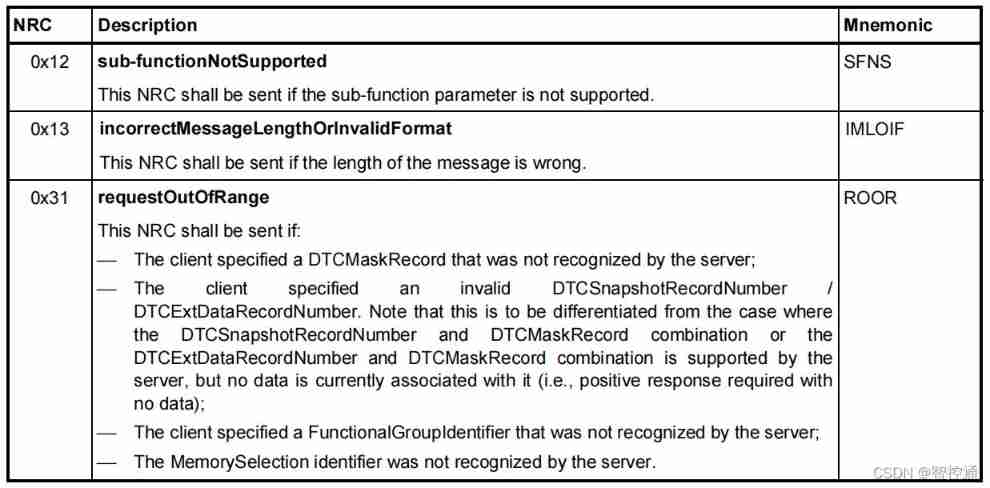
边栏推荐
- QT creator specifies dependencies
- 【博主推荐】C#生成好看的二维码(附源码)
- Neo4j installation tutorial
- CSDN Q & a tag skill tree (V) -- cloud native skill tree
- Leetcode 461 Hamming distance
- JDBC原理
- [BMZCTF-pwn] 12-csaw-ctf-2016-quals hungman
- MySQL完全卸载(Windows、Mac、Linux)
- Did you forget to register or load this tag 报错解决方法
- Software testing and quality learning notes 3 -- white box testing
猜你喜欢
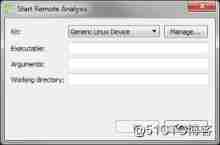
QT creator runs the Valgrind tool on external applications
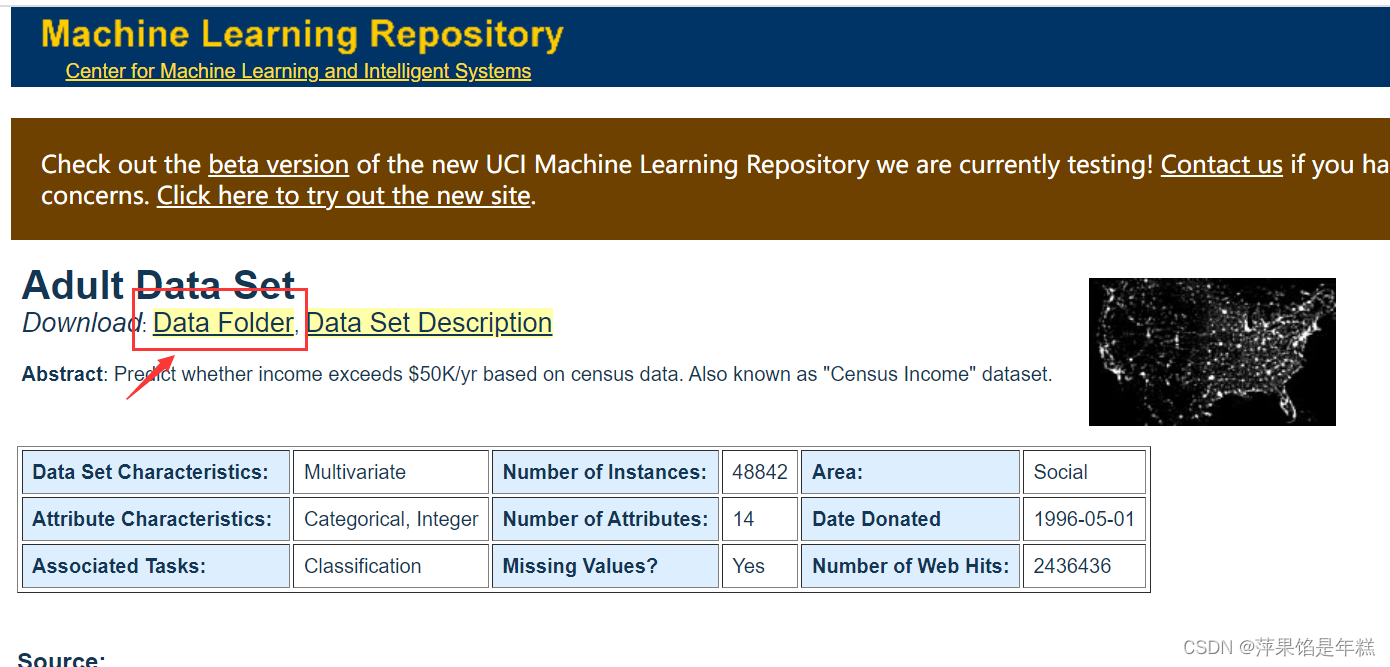
机器学习--人口普查数据分析
![[recommended by bloggers] asp Net WebService background data API JSON (with source code)](/img/04/c721e6177b578b30cbbf334cb1b6c9.png)
[recommended by bloggers] asp Net WebService background data API JSON (with source code)
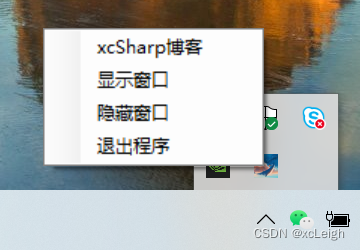
【博主推荐】C# Winform定时发送邮箱(附源码)

Copie maître - esclave MySQL, séparation lecture - écriture
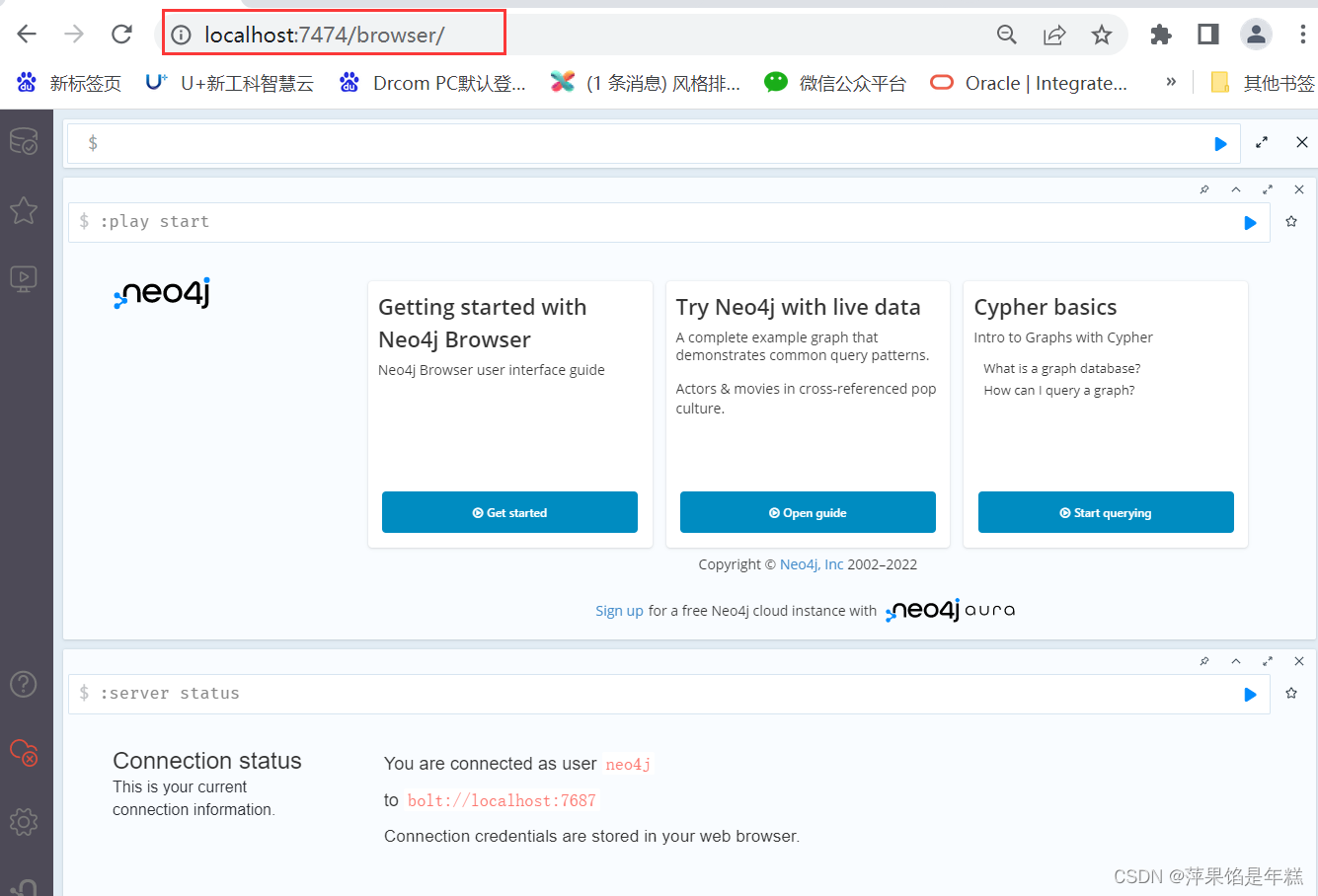
Neo4j installation tutorial
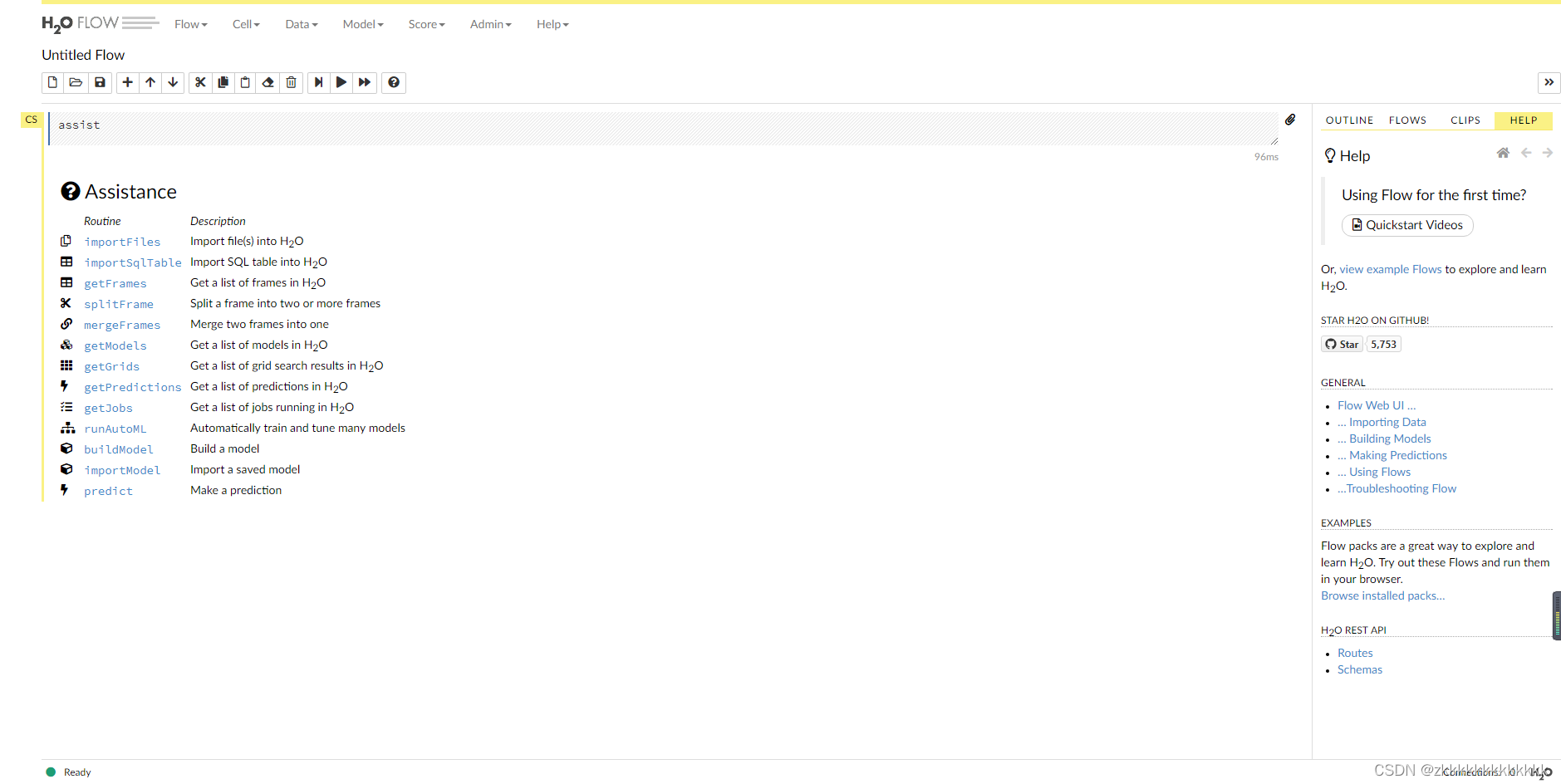
Introduction and use of automatic machine learning framework (flaml, H2O)

Pytorch基础

neo4j安装教程
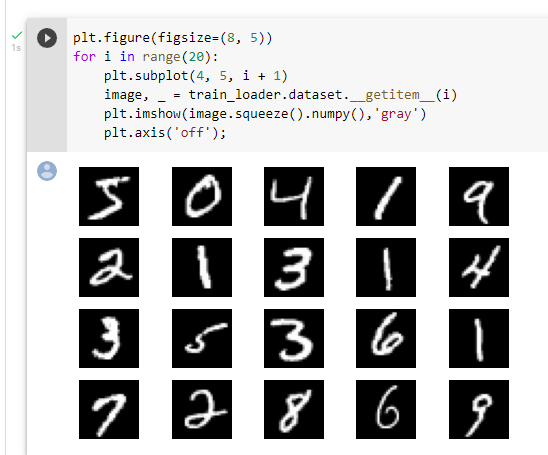
机器学习笔记-Week02-卷积神经网络
随机推荐
Did you forget to register or load this tag
解决安装Failed building wheel for pillow
npm一个错误 npm ERR code ENOENT npm ERR syscall open
SSM integrated notes easy to understand version
01 project demand analysis (ordering system)
Ansible practical series I_ introduction
Why can't STM32 download the program
Django运行报错:Error loading MySQLdb module解决方法
The virtual machine Ping is connected to the host, and the host Ping is not connected to the virtual machine
Principes JDBC
Navicat 导出表生成PDM文件
【博主推荐】SSM框架的后台管理系统(附源码)
导入 SQL 时出现 Invalid default value for ‘create_time‘ 报错解决方法
[C language foundation] 04 judgment and circulation
MySQL完全卸载(Windows、Mac、Linux)
[recommended by bloggers] background management system of SSM framework (with source code)
Armv8-a programming guide MMU (2)
FRP intranet penetration
Basic use of redis
Postman environment variable settings
